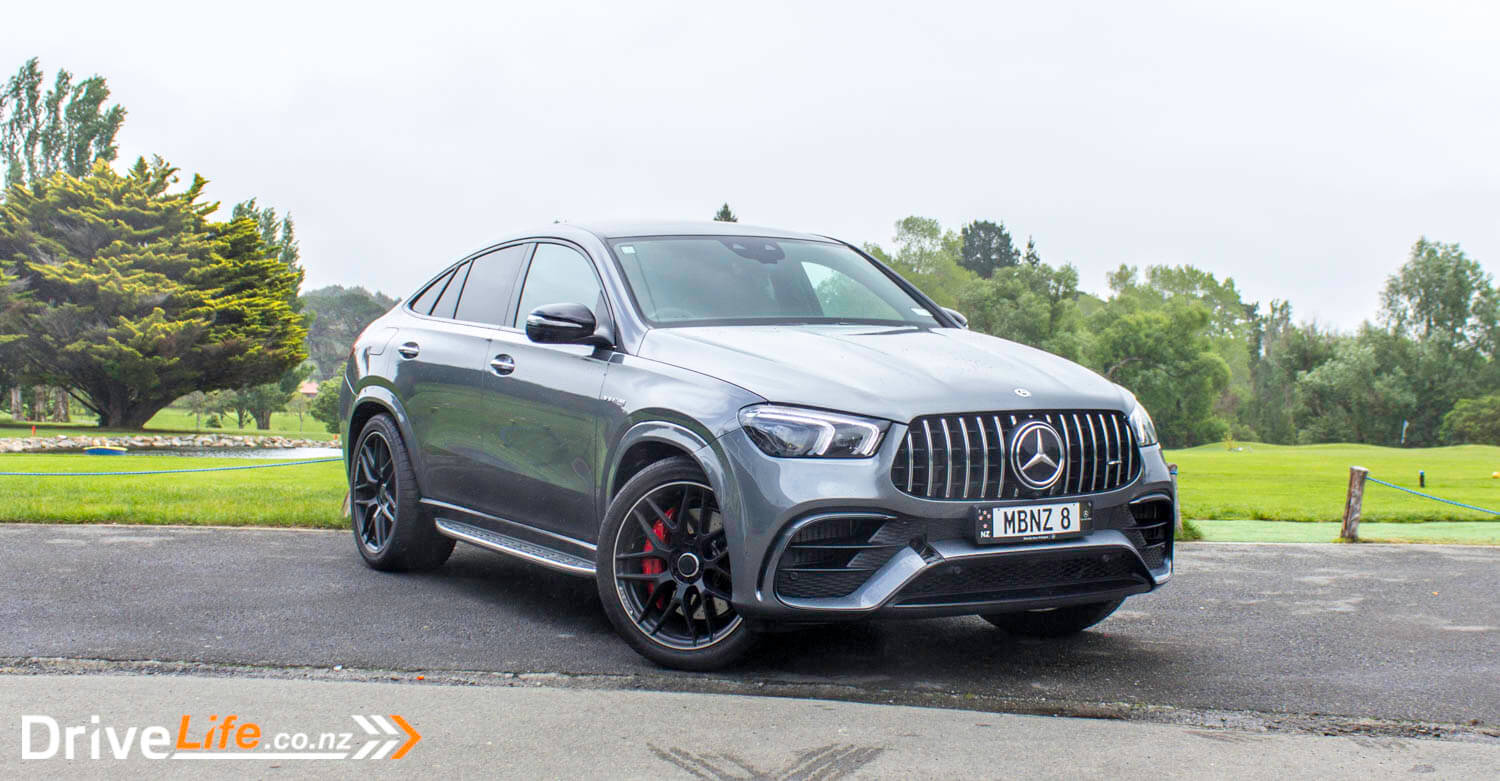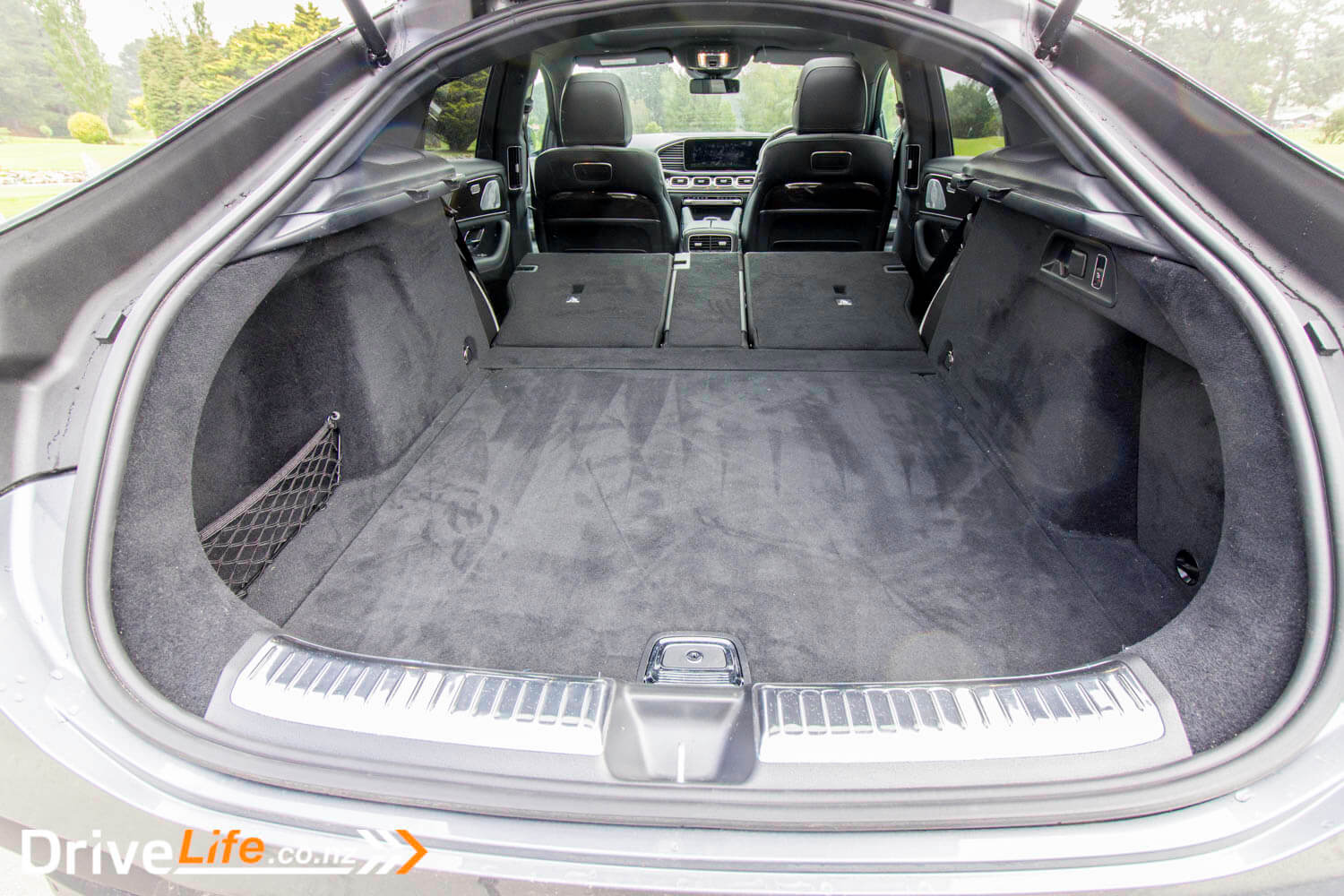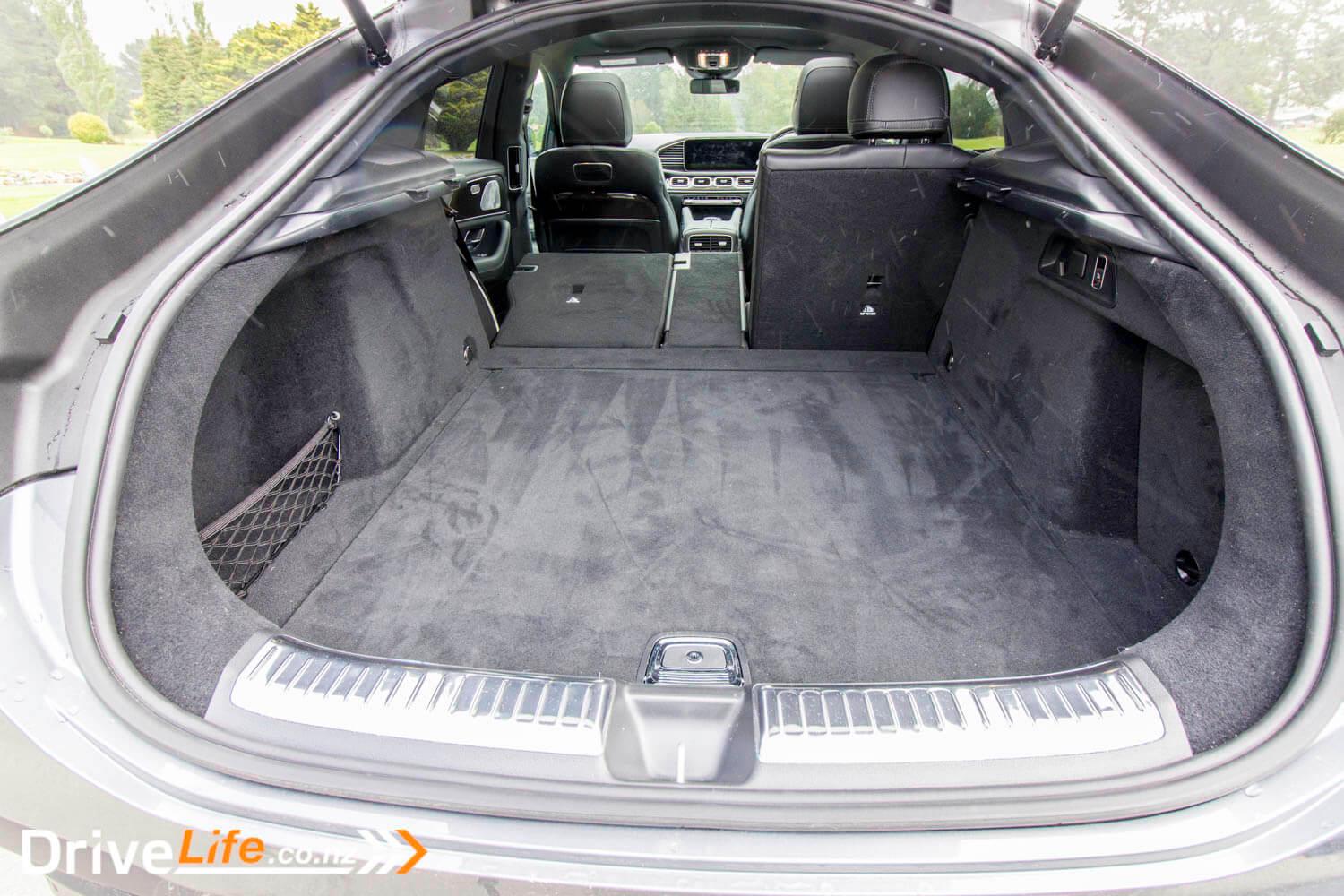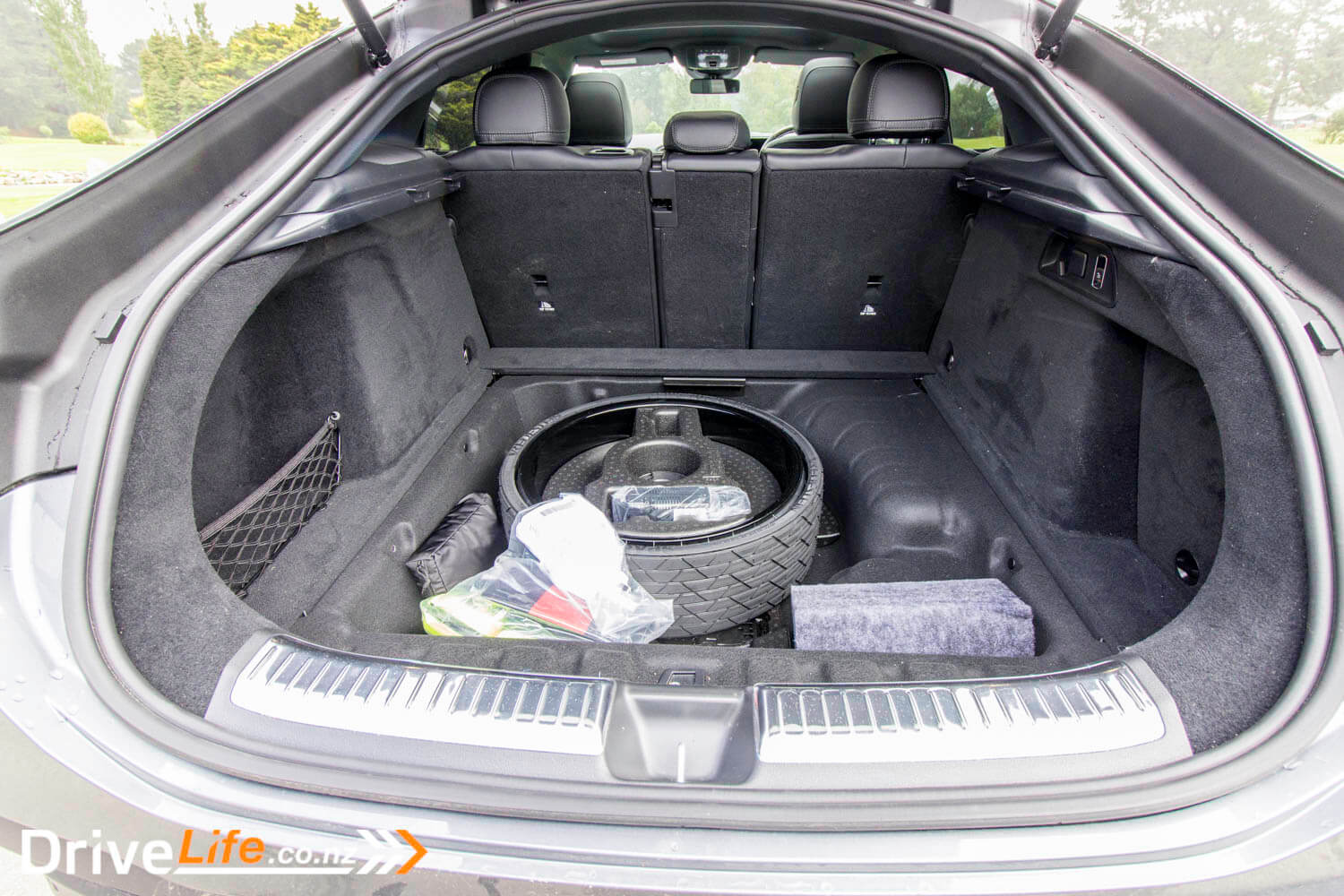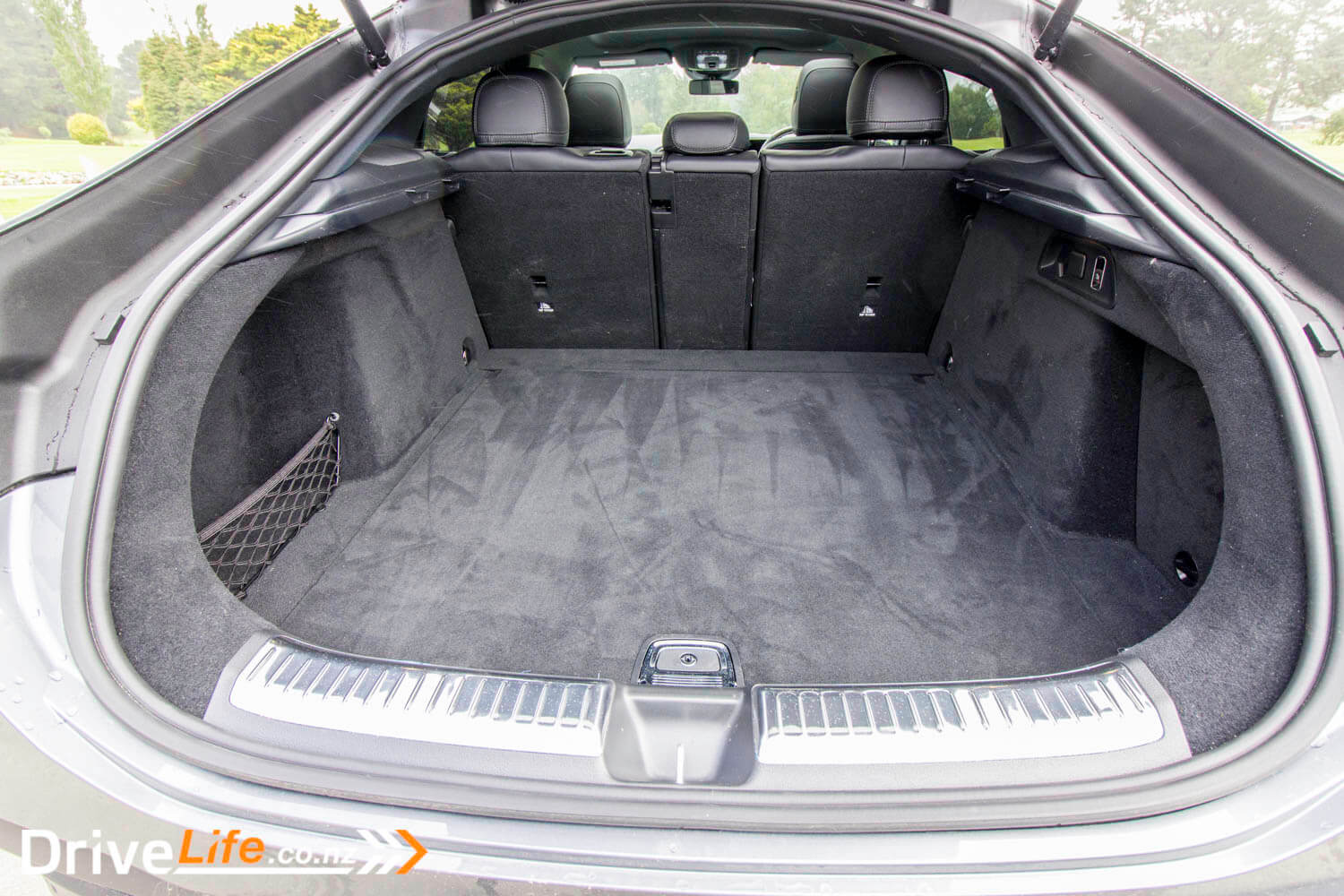It’s been just over 20 years since Mercedes-Benz released their first high-performance SUV (the ML55), and now – as if there was anything wrong with the GLE diesel – it seems that throwing out that gem of a 3.0-litre, 6-cylinder diesel-turbo and putting in a twin-turbo, 4.0-litre petrol V8 was going to be a good idea.
Then there’s the numbers. While the original ML55 had 250kW of power, the AMG GLE 63 S manages 450kW, or 600 old-school horsepower. Torque? A stump-pulling 850Nm.
Is it a step too far? Do we need a 450kW V8 SUV on the road, one that gets to the speed limit in 3.8 seconds? We took the Mercedes-AMG GLE 63S Coupe out for a week to see if it’s as good as the specs sound.
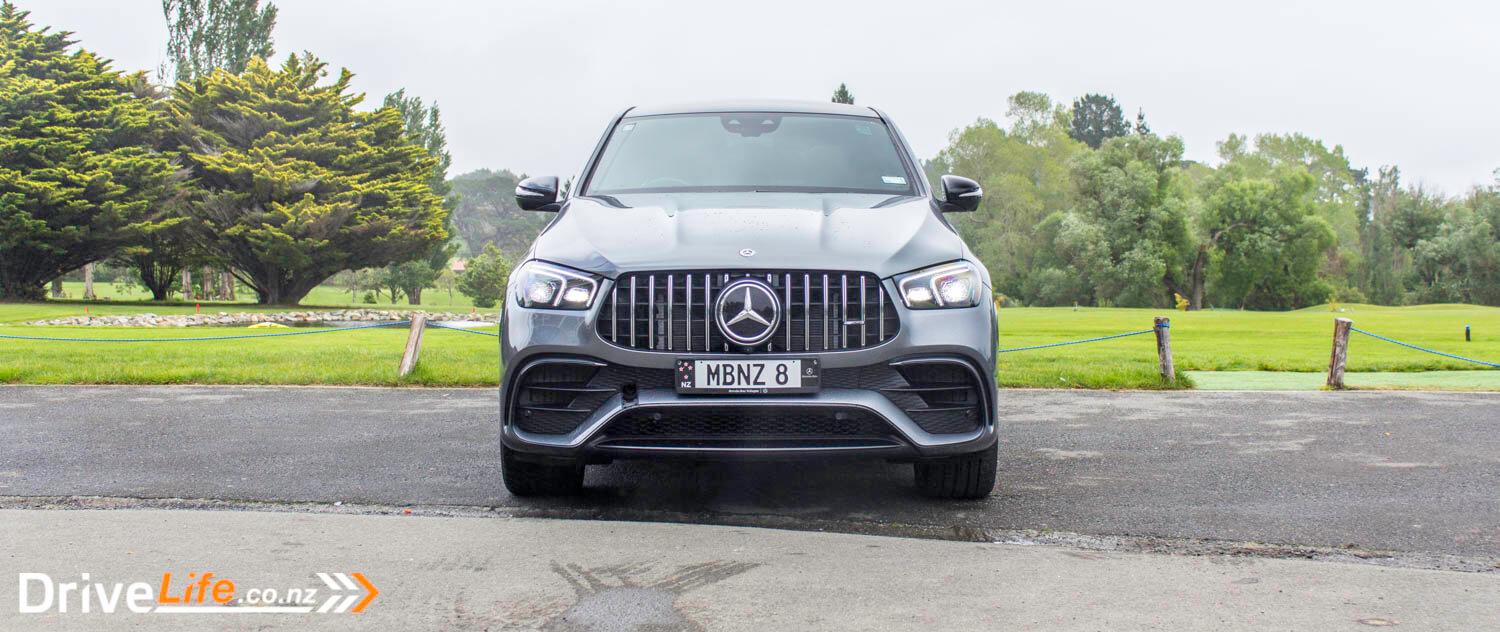
What’s In The 2020 Mercedes-AMG GLE Range?
There’s the two AMG-based GLE models in the range, the 53 4MATIC+ Coupe, and the 63 S 4MATIC+ Coupe. The 53 runs a 3.0-litre, turbo V6 that outputs 320kW of power and 530Nm of torque, and includes the 48-volt EQ Boost system. This model can get to 100Km/h in 5.3 seconds, and fuel economy is rated at 9.3L/100Km.
The 63 S has a twin-turbocharged V8 (also with EQ Boost) and giving you 450kW and 850Nm. 100Km/h comes up in 3.8 seconds, and fuel economy is suggested as 12.6L/100Km.
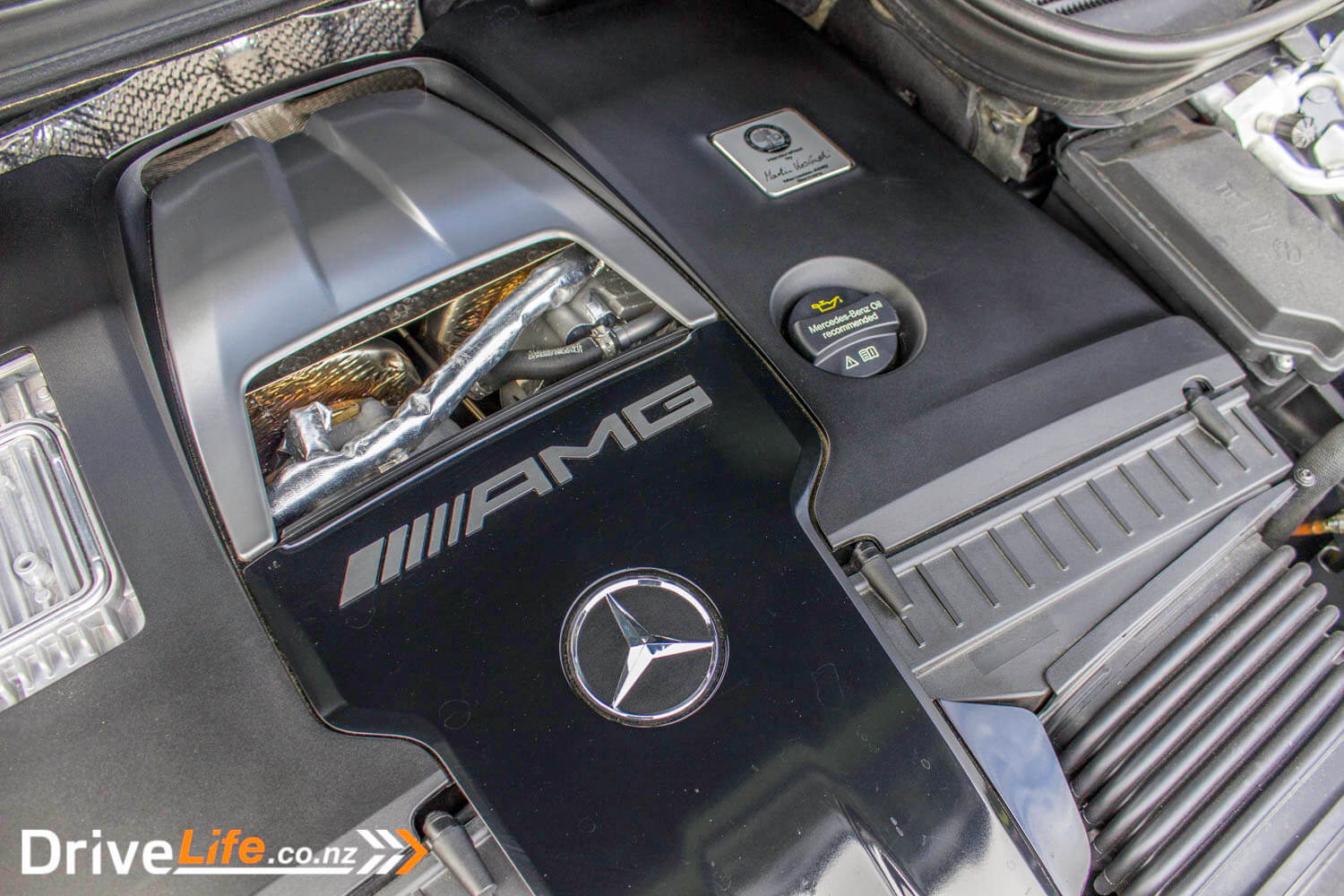
Both cars are petrol-powered, run a 9-speed automatic gearbox, and both are all-wheel drive using Mercedes-Benz’ 4MATIC system.
Features of the 53 include the AIRMATIC air suspension and adaptive damping system, a two-pipe selectable AMG performance exhaust system, AMG Night Package including heat-insulating dark-tinted glass, AMG performance steering wheel in Nappa leather, AMG door sill panels with illuminated AMG lettering, climatised front seats, and 21” AMG 5 twin-spoke alloy wheels.
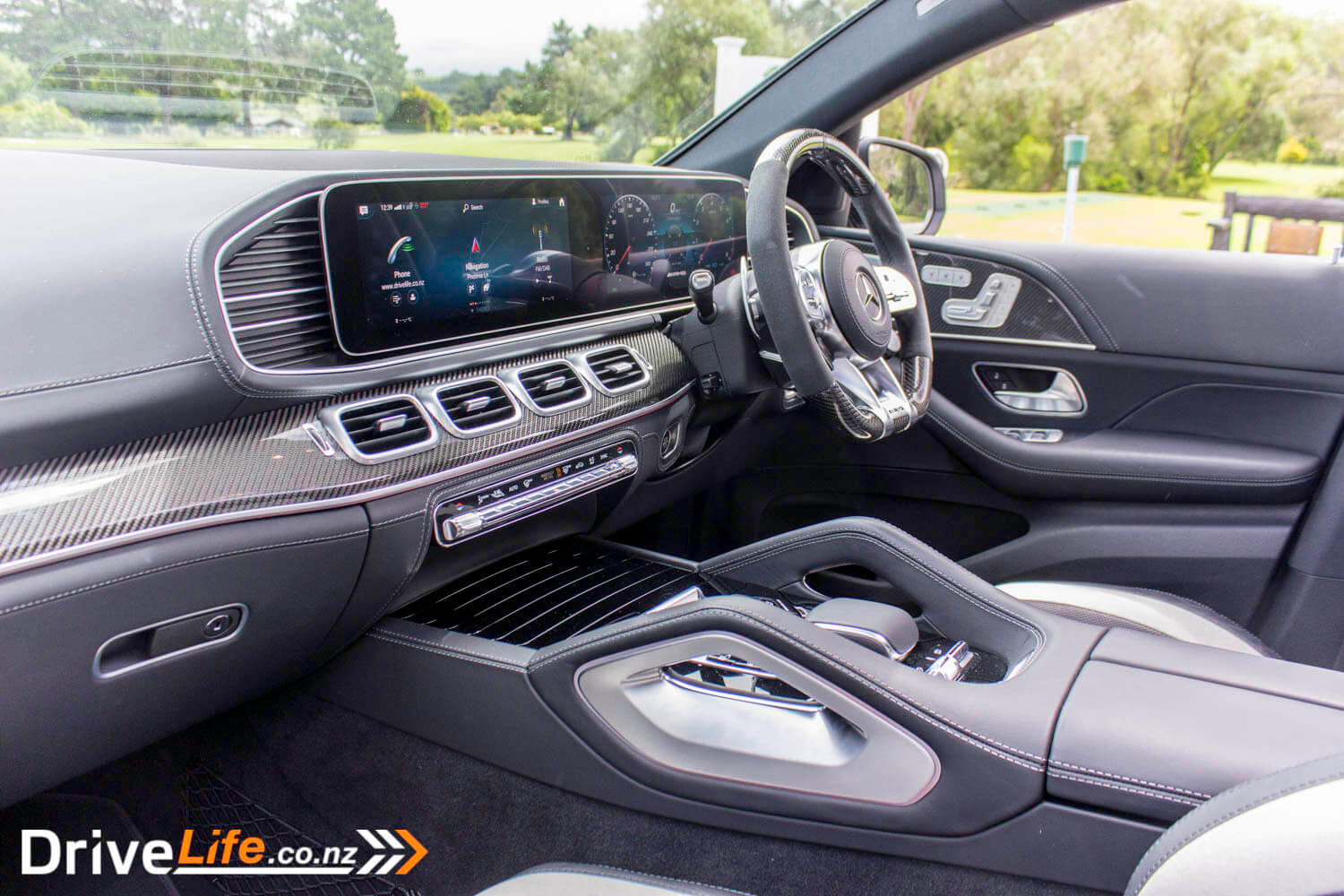
The GLE 53 also introduces a new suspension technology, AMG RIDE CONTROL+ with AMG Active Ride Control. This incorporates 48-volt active roll-stabiliser bars which Mercedes-Benz says that in cooperation with AIRMATIC, offers continuously variable adjustable damping. They say the result is enhanced vehicle dynamics and comfort, both on and off the road, working in tandem with a more direct steering ratio.
In addition to the 53’s features, the 63 S also adds an AMG electronic limited slip rear diff, AMG high performance composite braking system, the AMG Track Pace app, and Driving Assistance Package Plus. Additionally there’s five-zone air conditioning, there’s seats finished in AMG Exclusive Nappa leather, the Warmth Comfort Package, ENERGIZING Package Plus, AIR BALANCE Package, dashboard and door beltlines in Nappa leather, THERMOTRONIC automatic climate control, Active Traffic Assist, power-closing doors, a heated windscreen washer system, and 22” AMG cross-spoke light alloy wheels.
There’s more details on the features that come standard on the review of the GLE.

PRICING
Mercedes-AMG GLE 53 4MATIC+ Coupe: $185,100
Mercedes-AMG GLE 63 S 4MATIC+ Coupe: $236,000
Our test car had the Carbon Fibre package ($4,200) and heated rear seats ($900) to bring the price up to $241,100.
You can read more about the AMG GLE 63 S Coupe on Mercedes-Benz’ New Zealand website.
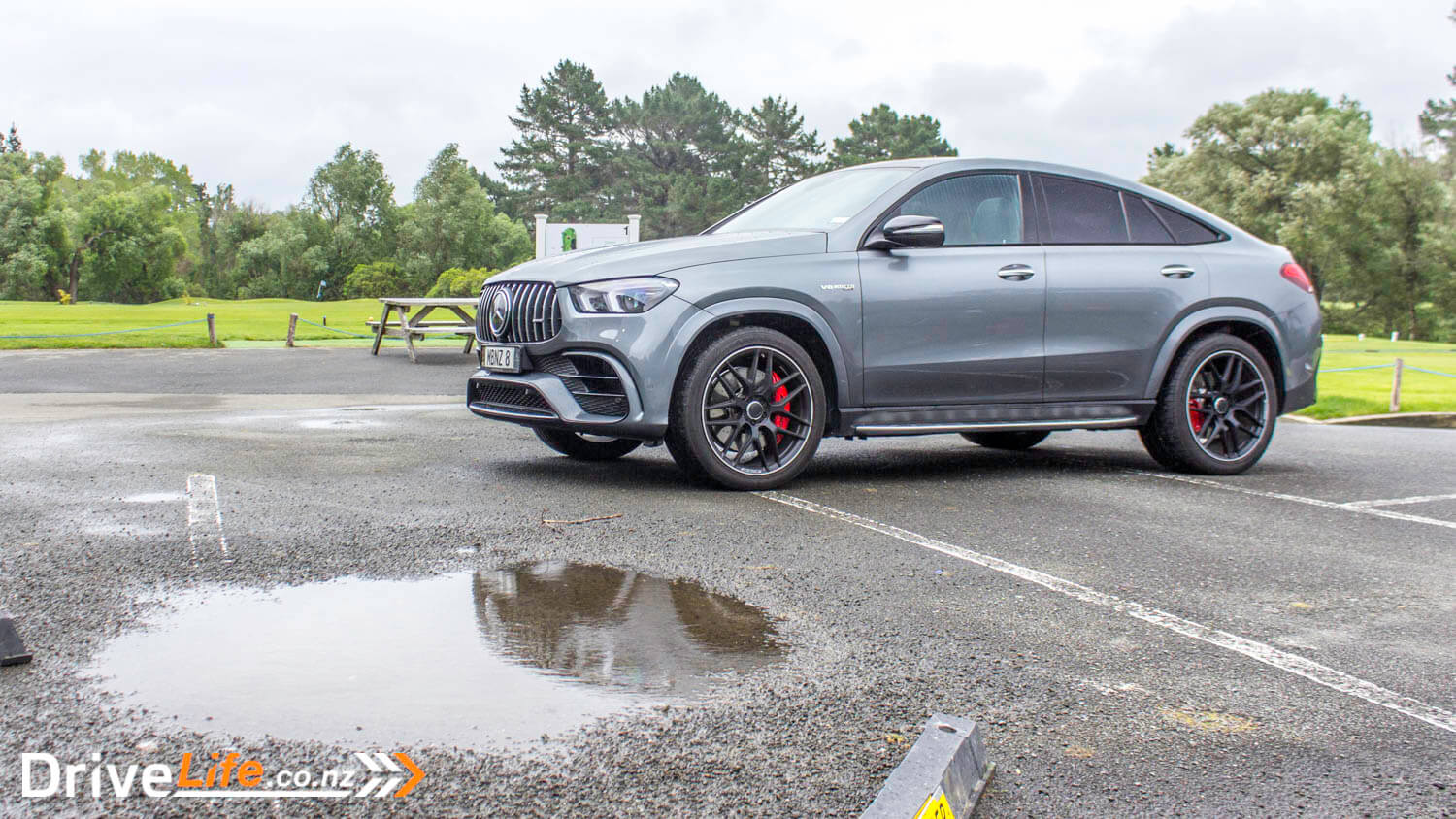
First Impressions Of The 2020 Mercedes-AMG GLE 63 S Coupe
I think the words that I was looking for were Big and Imposing. This car seems to tower over you, with its shark-tooth grille, seemingly waiting to gobble up lesser cars as it drives over them.
And of course, it had to be grey – my most non-favourite colour. Our test car was the coupe version of the GLE SUV, and I’m not sure that Mercedes-Benz – or BMW for that matter – have quite nailed the fastback/sportback/coupe design for an SUV just yet. Audi seems to have done a good job, but the GLE coupe just didn’t look quite right to my eyes. Others liked it, and others did not. Totally a personal choice and if you don’t like it, you can simply choose the SUV model instead.
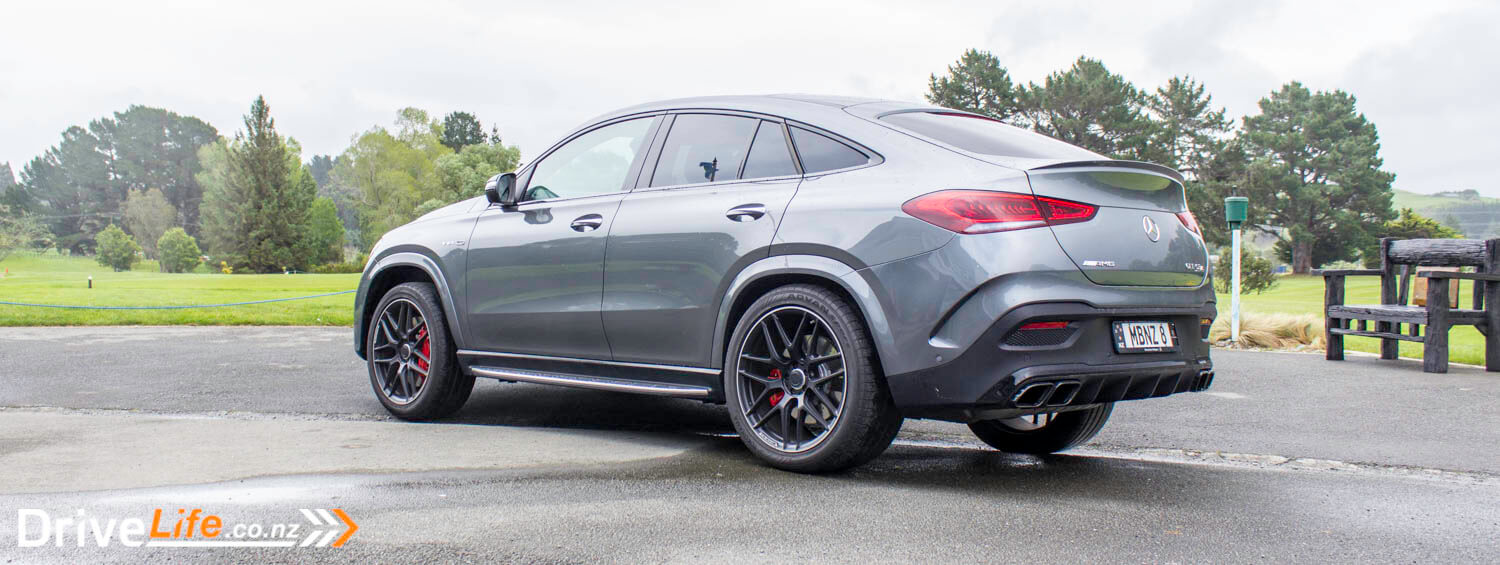
There’s no mistaking that grille though, and side-on, those 22” rims that come as standard. Black rims of course, and I must admit they suited the car. This car has a stunning set of alloys.
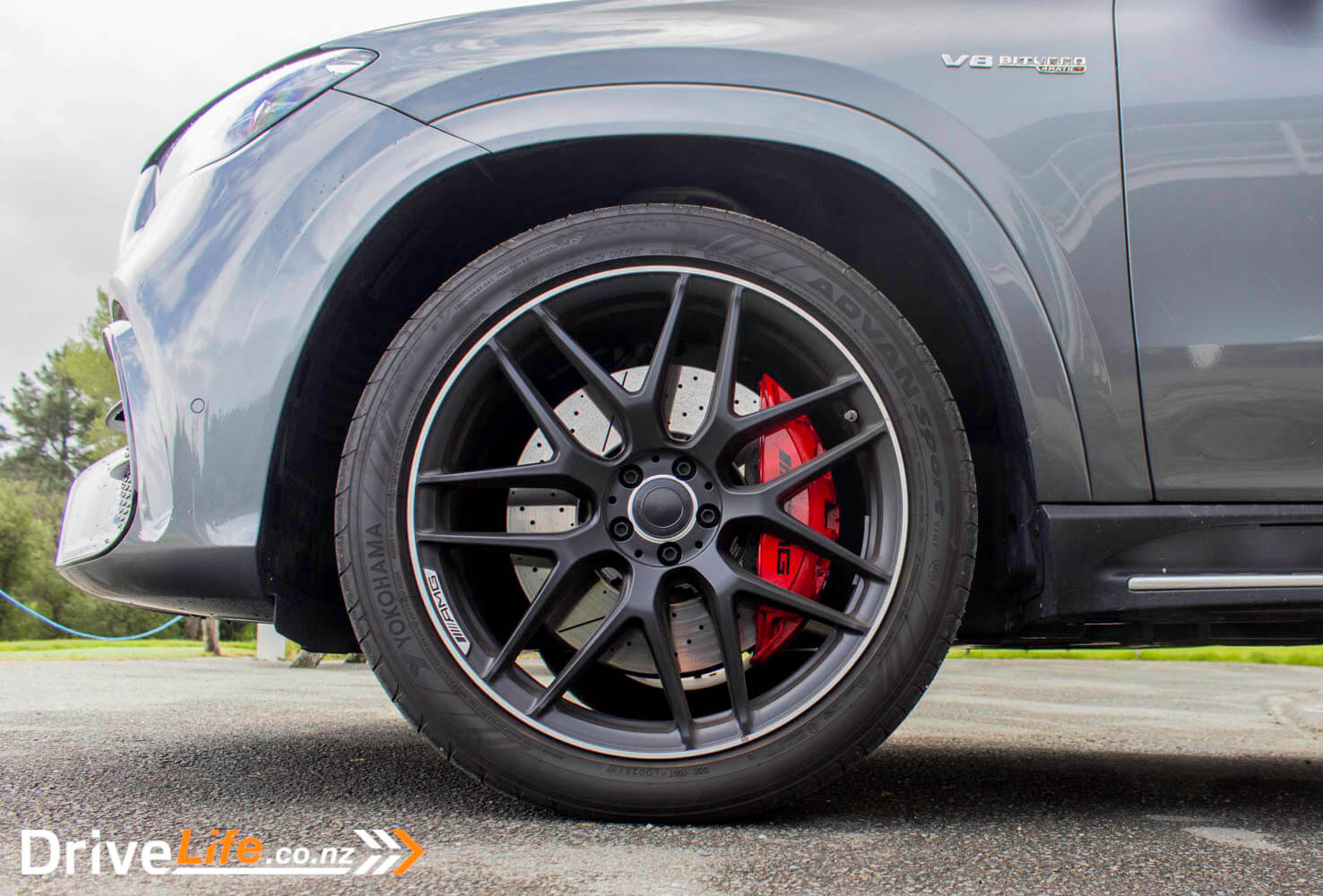
Around the back, it’s a bit nicer, with that sloping rear window, down to the small, integrated spoiler and a nice set of taillights. Naturally – because AMG – there’s quad exhaust tips ready to spit out crackles and pops in the odd tunnel. Not that you’d do that, of course.

The new model GLE Coupe is 39mm longer and 7mm wider than the previous model, including 20mm extra on the wheelbase. The Coupe is 60mm shorter than the GLE SUV, although as you can imagine it’s hard to notice those differences without the cars being side by side.
What’s The Interior Like On The 2020 Mercedes-AMG GLE 63 S Coupe?
Our test car had the optional Carbon Fibre package, at $4,100. That means there’s carbon fibre on the doors, dash, and even on the steering wheel. The top and bottom of the wheel are carbon fibre, while the other half is DINIMICA microfibre. Was carbon fibre worth it? I think you’ll either want the carbon fibre, or not. It wasn’t for me, but it did add a touch of sportiness to the AMG.
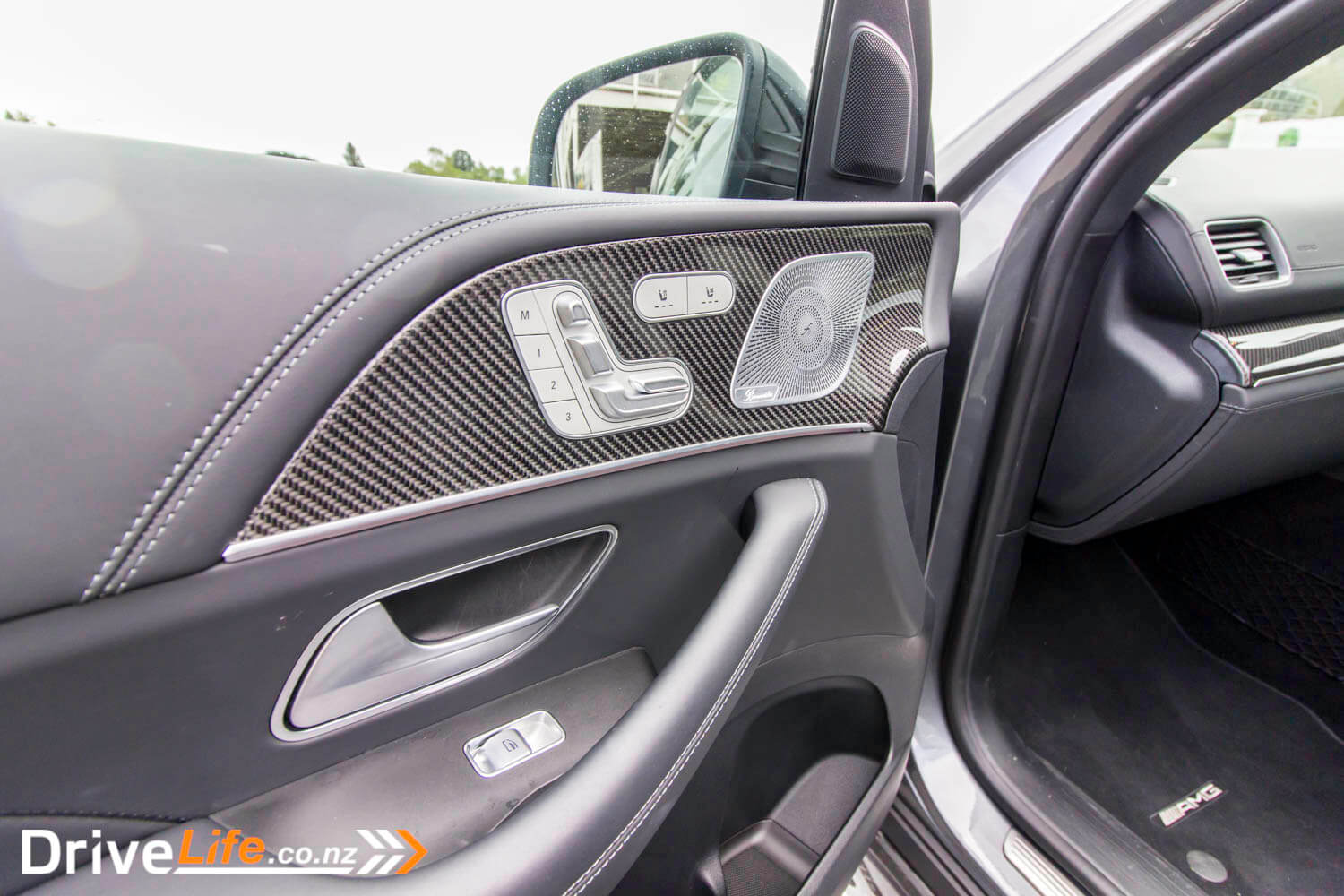
Up front, there’s 2 USB-C ports and another single one in the centre cubby. There’s also a 12-volt socket up front for your radar detector – that might be essential equipment in this car.
As you’d expect for a ‘sporty’ car, the interior is all black. Thankfully, there’s a huge panoramic sunroof with an electric blind to let some light in. The seats are the best in the business, both in look and comfort. There’s a huge array of settings for them, and this model also has heated arm rests on the doors, and the centre console armrest is heated – these are turned on when you turn on the seat heater.
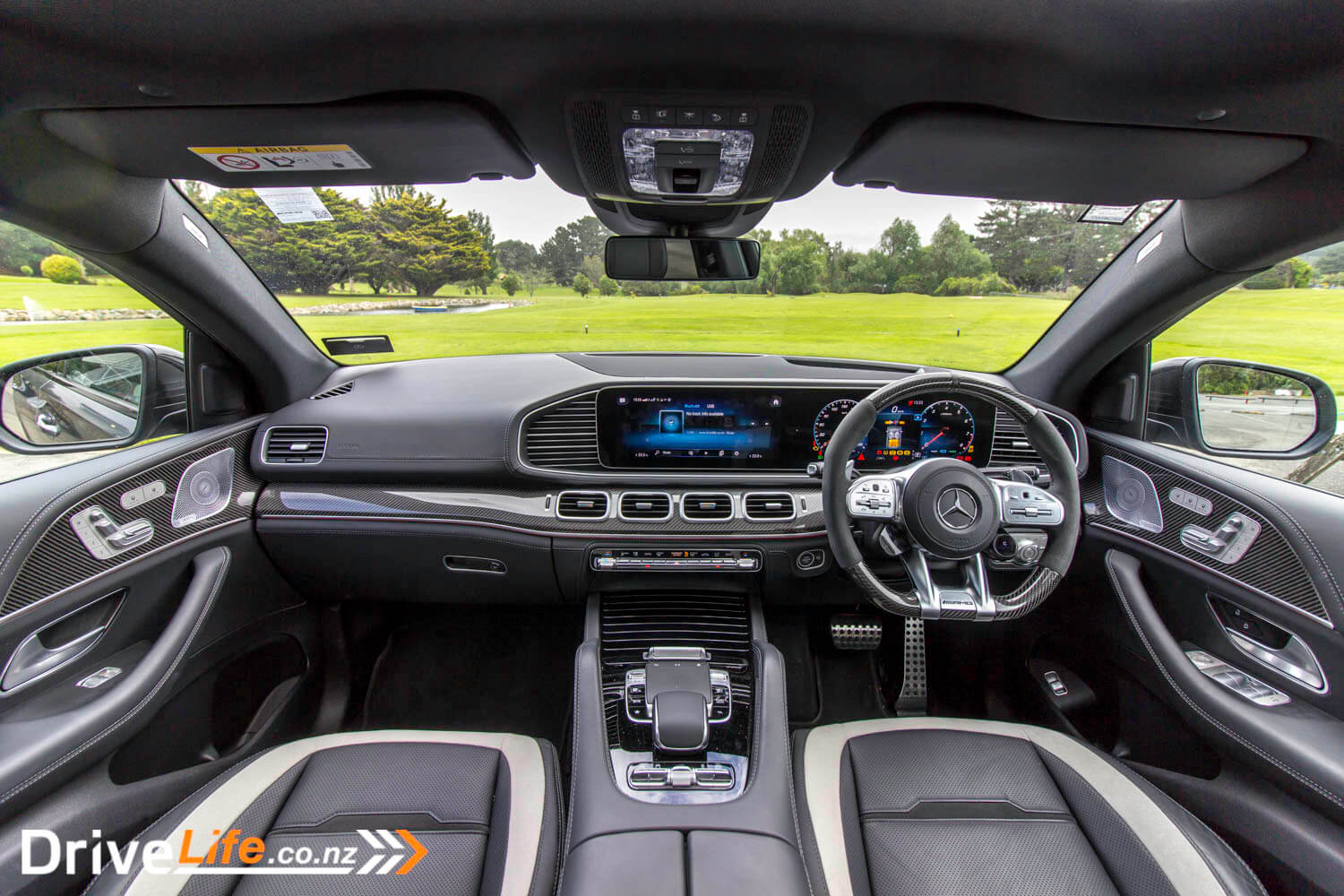
Rear seats passengers are looked after pretty well, with plenty of headroom once you are in, but they may need to duck on way in because of the roof line. Rear legroom is excellent, and there are side AC air vents with centre controls. You can read more about the interior in our review of the GLE, or also on our Far North Adventure in a GLE.
The boot can’t help but be smaller than that of the SUV, but according to Mercedes-Benz the 2020 Coupe does have 40 extra litres of space over the previous version.
What Does The 2020 Mercedes-AMG GLE 63 S Coupe Drive Like?
I’ll be honest, my first impression on getting into the AMG was a little disappointing. There, on the lower spokes of the steering wheel, are some AMG-only controls; you can adjust the AMG DYNAMICS, or adjust the suspension from the left side, and on the right is a dial where you can change the drive modes. This is all very nice, but the controls are plastic, and look cheap. Not only that, but they feel cheap to use, and do wobble around a little. This stands out more because the rest of the controls in the car are so beautifully made, feeling sublime and like total quality. That was my only ‘complaint’ about the interior, the rest of it is standard GLE, and that’s just fine by me. More about those controls later.
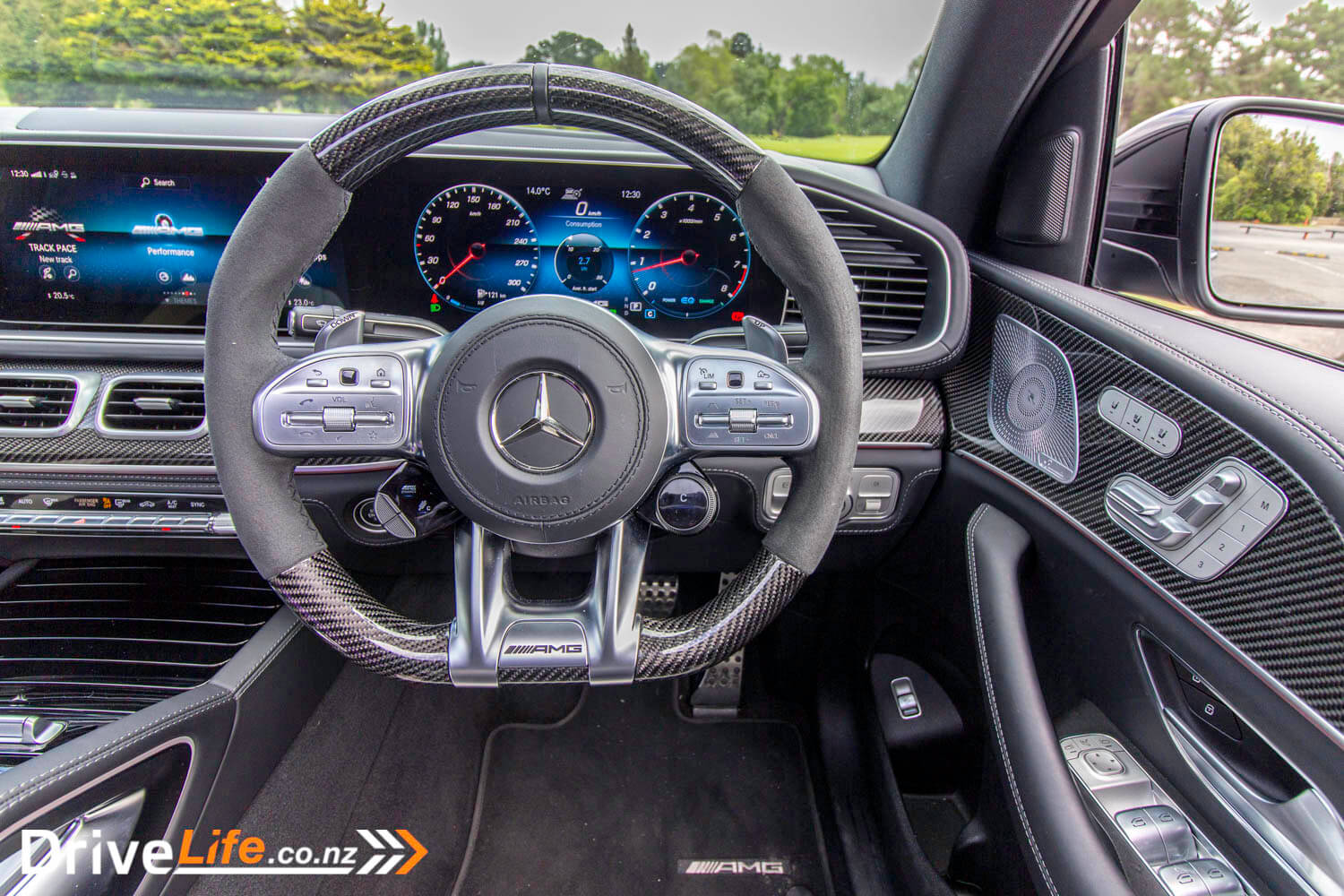
Of course, you have to start the engine to get the car moving, and like any AMG, this is an experience in itself. Yes, it burbles, and it burbles very nicely. There’s the mandatory button on the centre console to open the second exhaust pipe, and this will change the engine note not only to be louder, but it takes on a more baritone sound – and that’s just at idle.
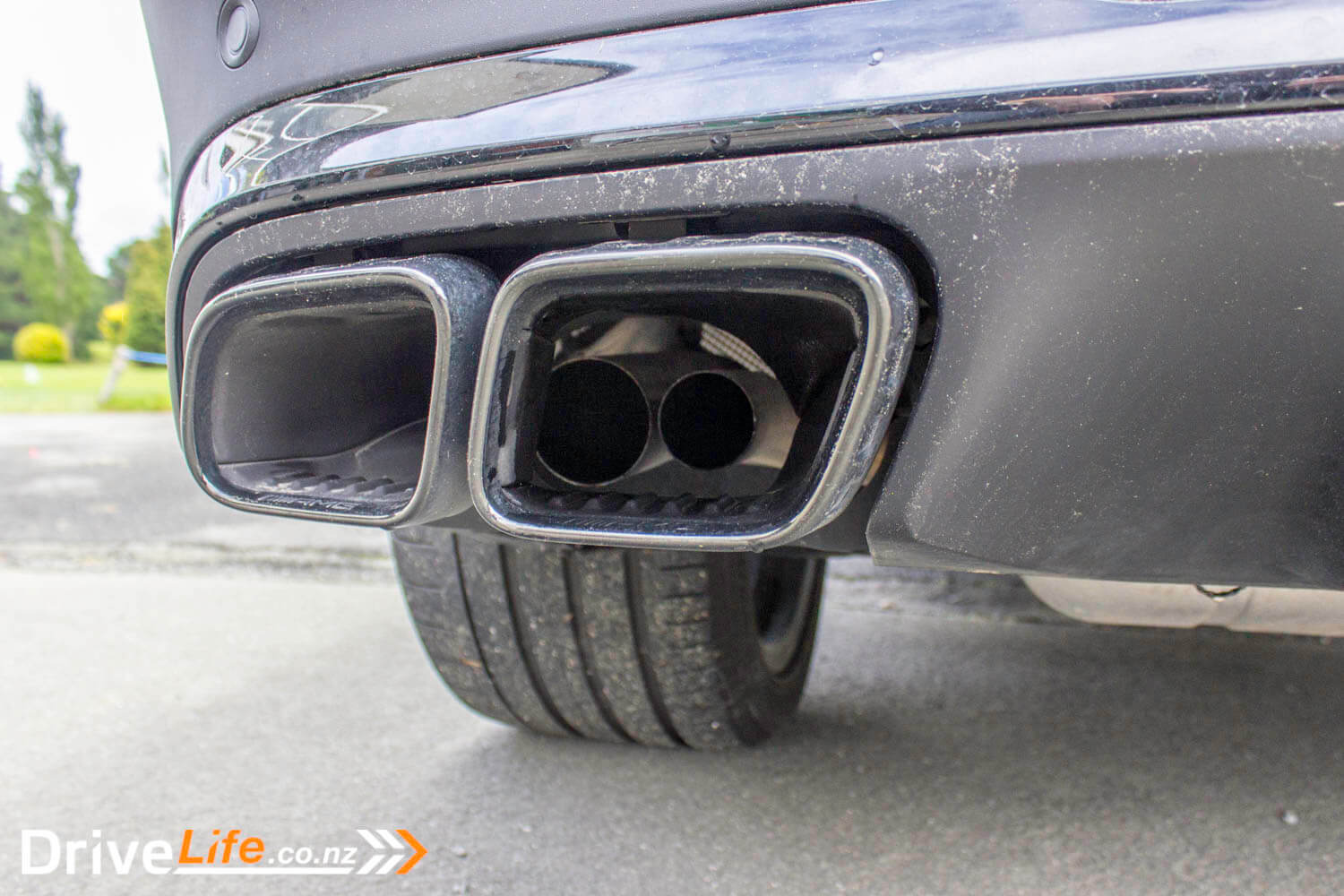
Before driving off, there’s the 48-volt EQ Boost system to consider. This means the integrated starter-alternator not only provides additional thrust, it also recuperates braking energy. Mercedes-Benz says a modern 48-volt on-board electrical system reliably provides energy and the additional compressor supplies torque from just above idle speed. What does this mean in reality?
For a start, it means no belts at all. No power steering belt, no alternator belt, no drive belts whatsoever. It also means that there’s a huge reduction in turbo lag, as the EQ Boost system kicks in instantly. Overall it should mean a smoother engine and therefore a smoother drive and less fuel consumed. It also means that when you stop the car at a red light, and the engine turns off to save fuel, when it starts again, there’s no actual starter motor sound. It’s quite a weird experience, as all of a sudden the engine is working, but didn’t sound like it actually started.
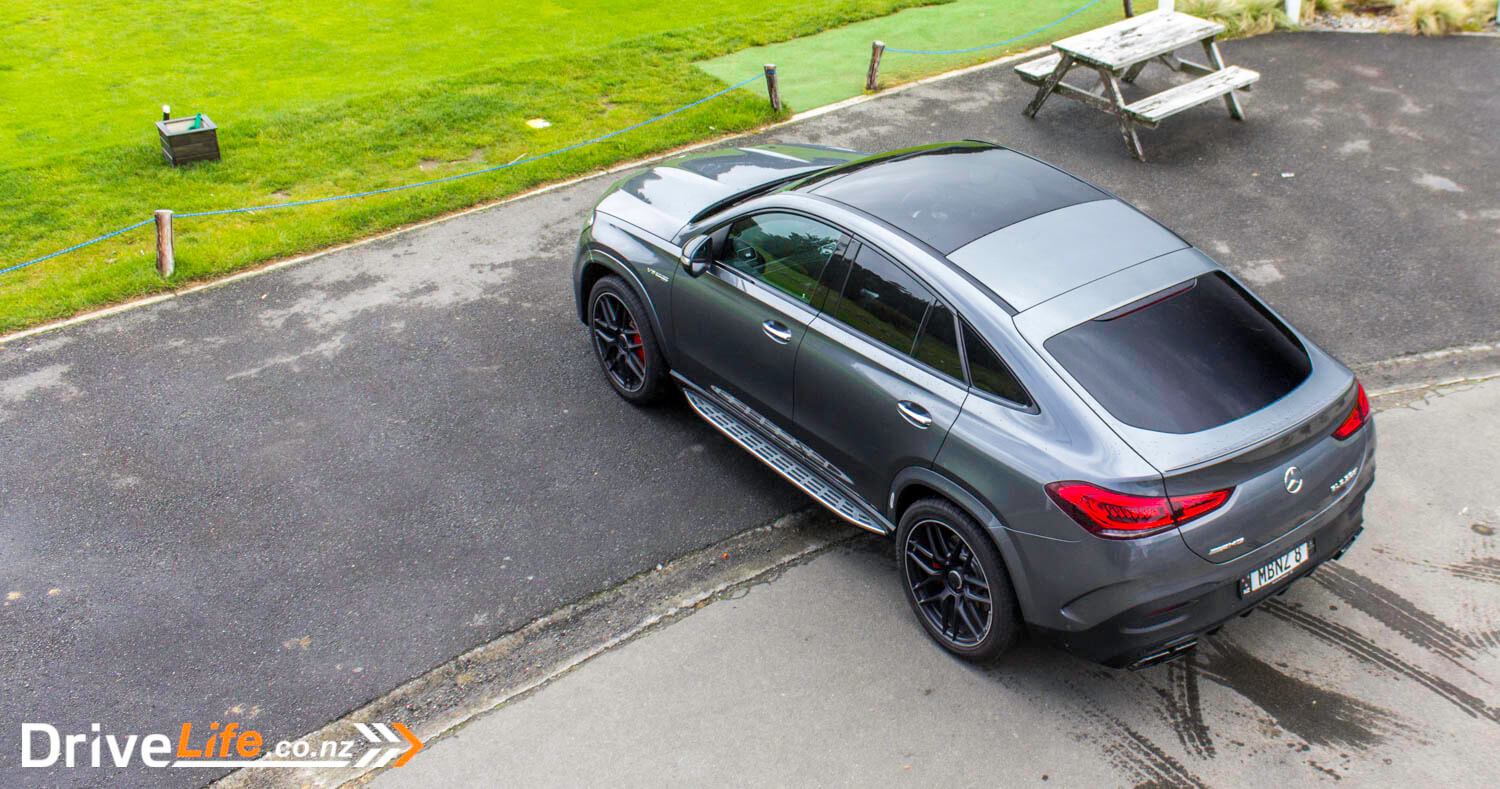
EQ Boost adds an extra 16kW of power and 250Nm of torque in short bursts, such as at take-off, but also acting as a power generator to assist in hybrid functions such as boost, recuperate, load point shift, gliding, and restarting the engine almost imperceptibly during start/stop. As mentioned above, this starting of the engine without seeming like it has actually started is not only weird, but works perfectly. It’s an incredible feature of the car.
On the road, the suede/Alcantara and leather mix seats are so comfortable, I could spend all day sitting and driving, stopping only to gas up. With a mixture of light and dark fabrics, the seats not only feel superb; they look excellent. There’s the normal range of electric adjustments, including the headrests; it’s always cool to see that when you move the seat backwards for taller people, the headrest automatically rises on that seat. It’s a small touch, but well thought out.
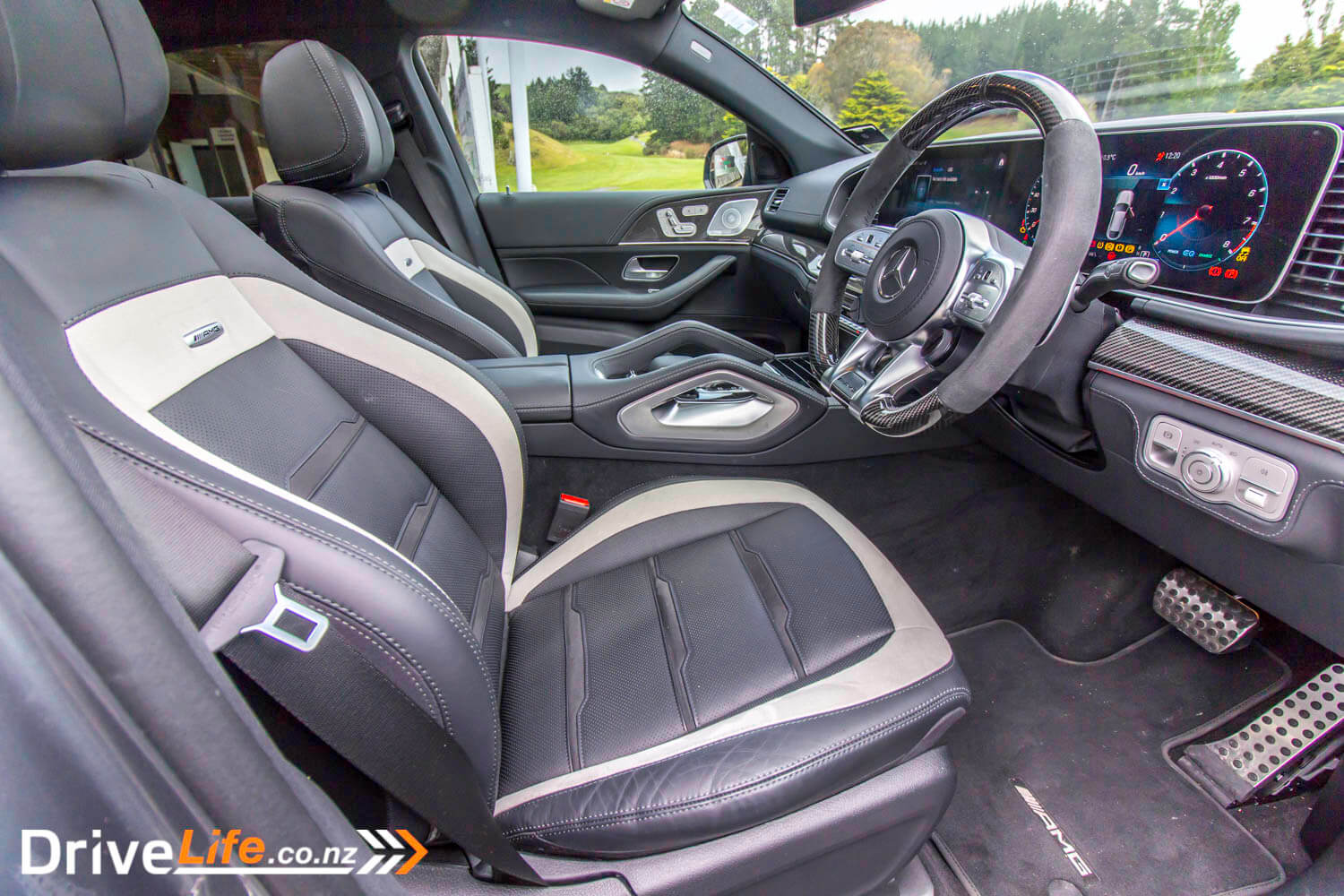
There’s also a massaging system, where you can pick from a range of different massaging options for the front seats, including having some heating thrown in after your day at the mountain, skiing. A nice touch here is that you can adjust the lumbar support in three different places on your back via dash controls; pick from upper, middle, or lower back, and tell the car just how much pressure you want on your back at any of those points.
So, is there much difference in driving the coupe over the standard GLE SUV? There are some notable differences. The rear window is now tiny, and for some reason it doesn’t have a wiper – and it needs one. Visibility is reduced out of the car, but of course there’s decent blind spot monitoring with rear cross traffic alert to help you out.
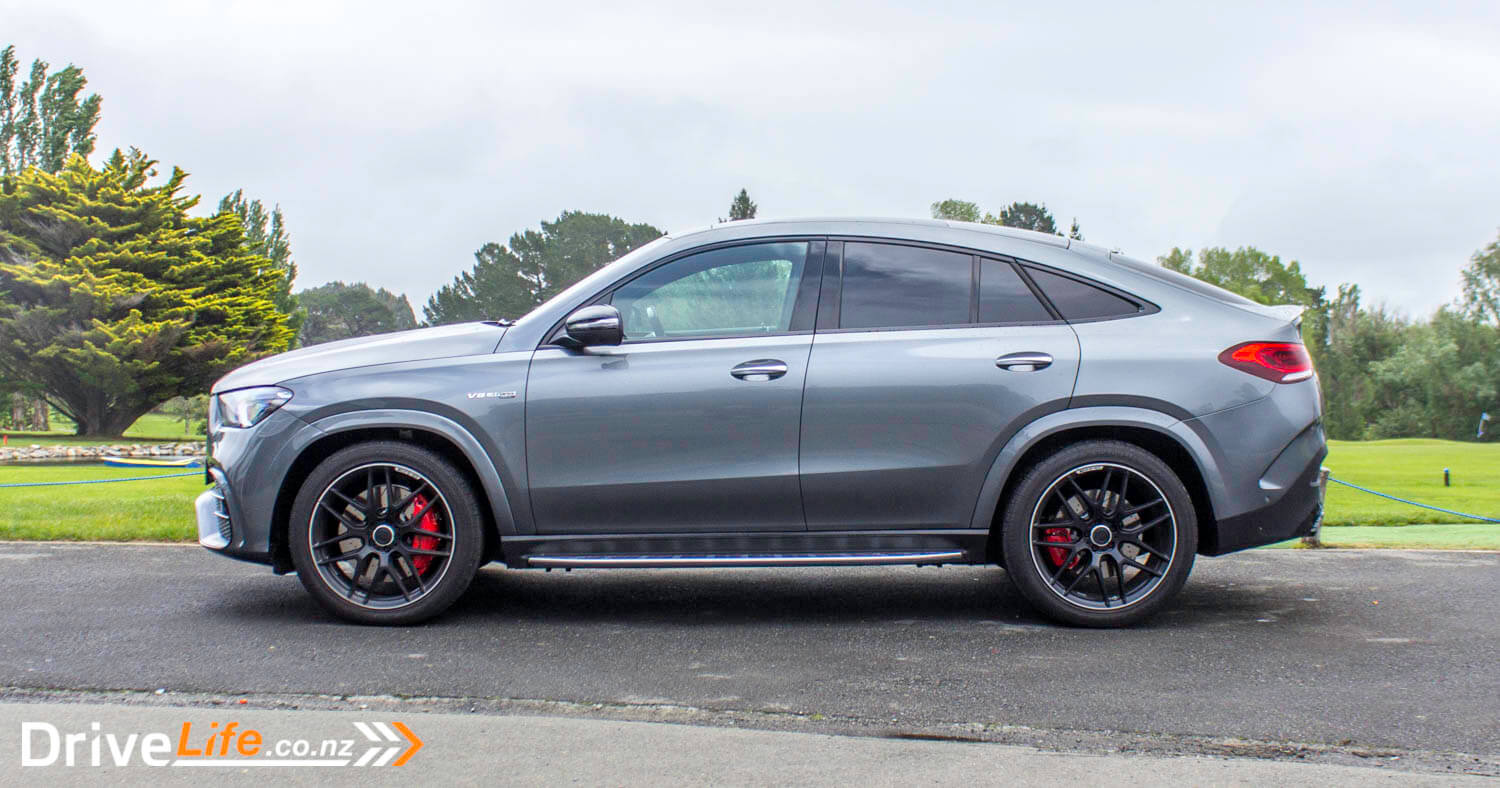
Mercedes-Benz suggests in their press release that the different body style and shorter overall length contributes to better handling. Does it? I’m going to say yes, probably. It’s a little hard to tell since the AMG GLE has different wheels and tyres – 22” rims are standard – so this has an impact on handling too. But overall, it feels tighter on the bends than the SUV model. It’s still big, there’s no doubt about that, but it does very well. During my week with the car, it poured down pretty much every day, so this wasn’t a time to test out the grip and handling comparison with the standard GLE, especially with 450kW on tap.
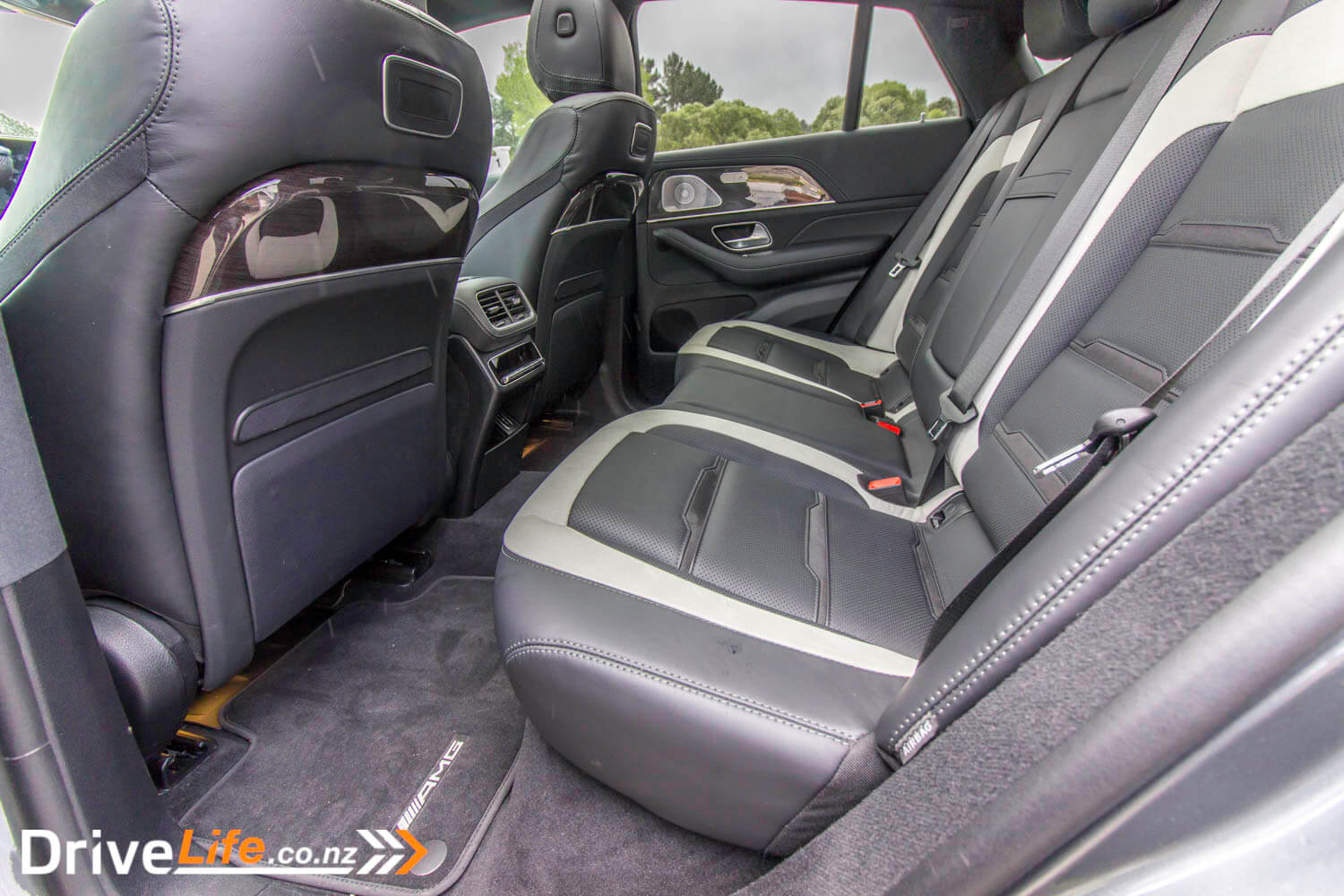
Steering is well weighted, and gets a lot heavier as you move up the drive modes. With those wide front tyres, steering feel is a little lacking, but still the car does very well, almost dropping into corners. In my opinion, the Audi RSQ8 does handle better, but not by much. I think a buyer would be very happy with either car.
Helping the sporty feeling inside the car is that small AMG sports steering wheel, flat bottom of course. Other than the extra steering wheel buttons and two-tone seating, there’s little inside the car to show it’s an AMG.
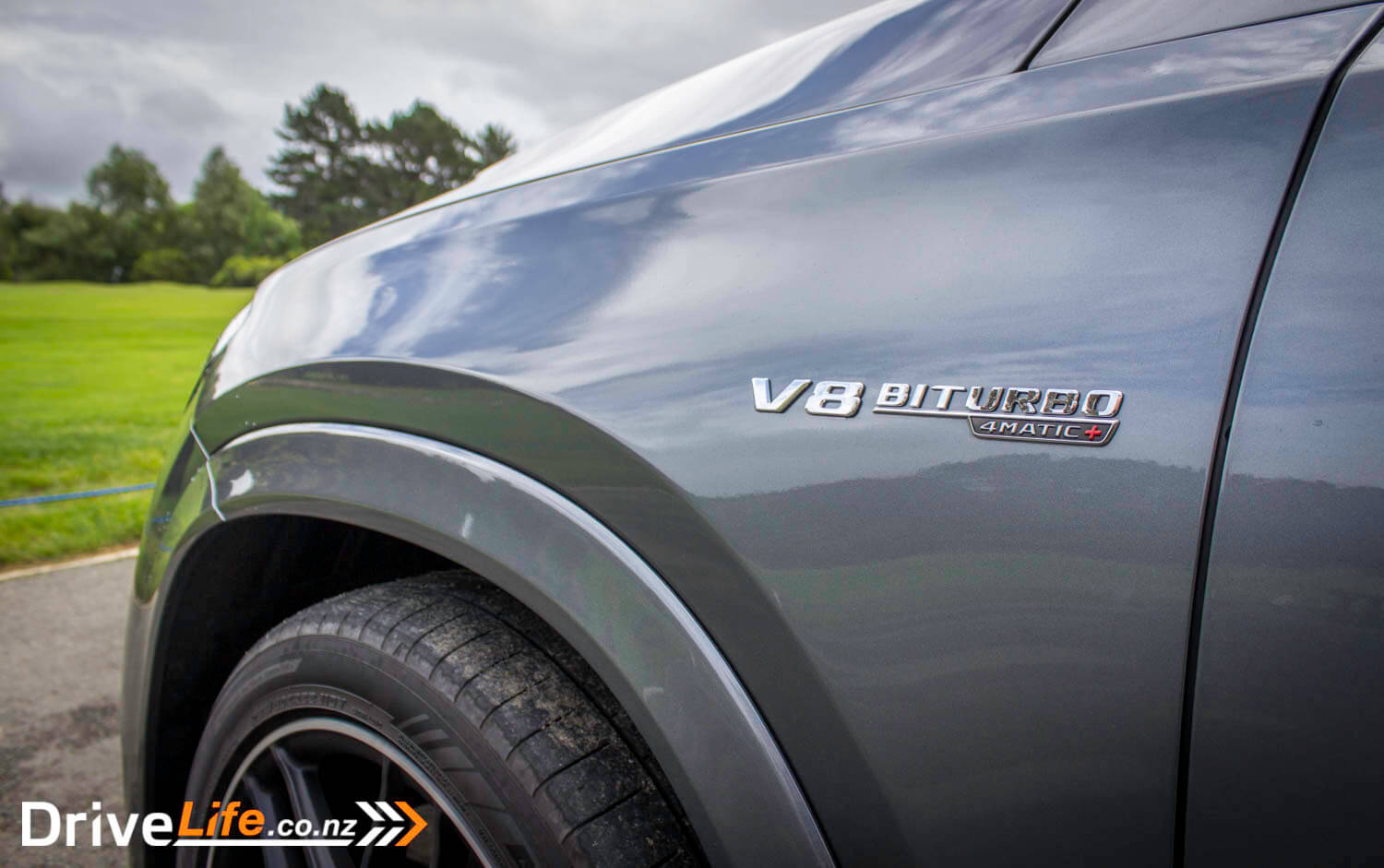
The AMG GLE s has fully automatic parking, as you’d expect. This is the first test car I’ve had where it is totally automatic. The AMG will do the brake, accelerator and gear changes for you; just sit back, and wait for the car to go into Park, and then you turn the engine off. Nicely done.
Other changes over the diesel GLE are the inclusion of a couple of screens in the MBUX infotainment system, TracK Pace, and AMG. With the Track Pace page, you can select from racetracks around the world, and the screen will help you drive it better, showing cornering lines, delta times and absolute times. It also shows you, and I quote, “Breaking points”. Bad choice of words there, and no idea how that spelling mistake made it past quality control. With Racetrack, there are no New Zealand tracks available, but you can ‘import’ your own track simply by driving on it, then the application will map the track out. There are 60 tracks stored, and you can also download an Android or Apple app of the same.
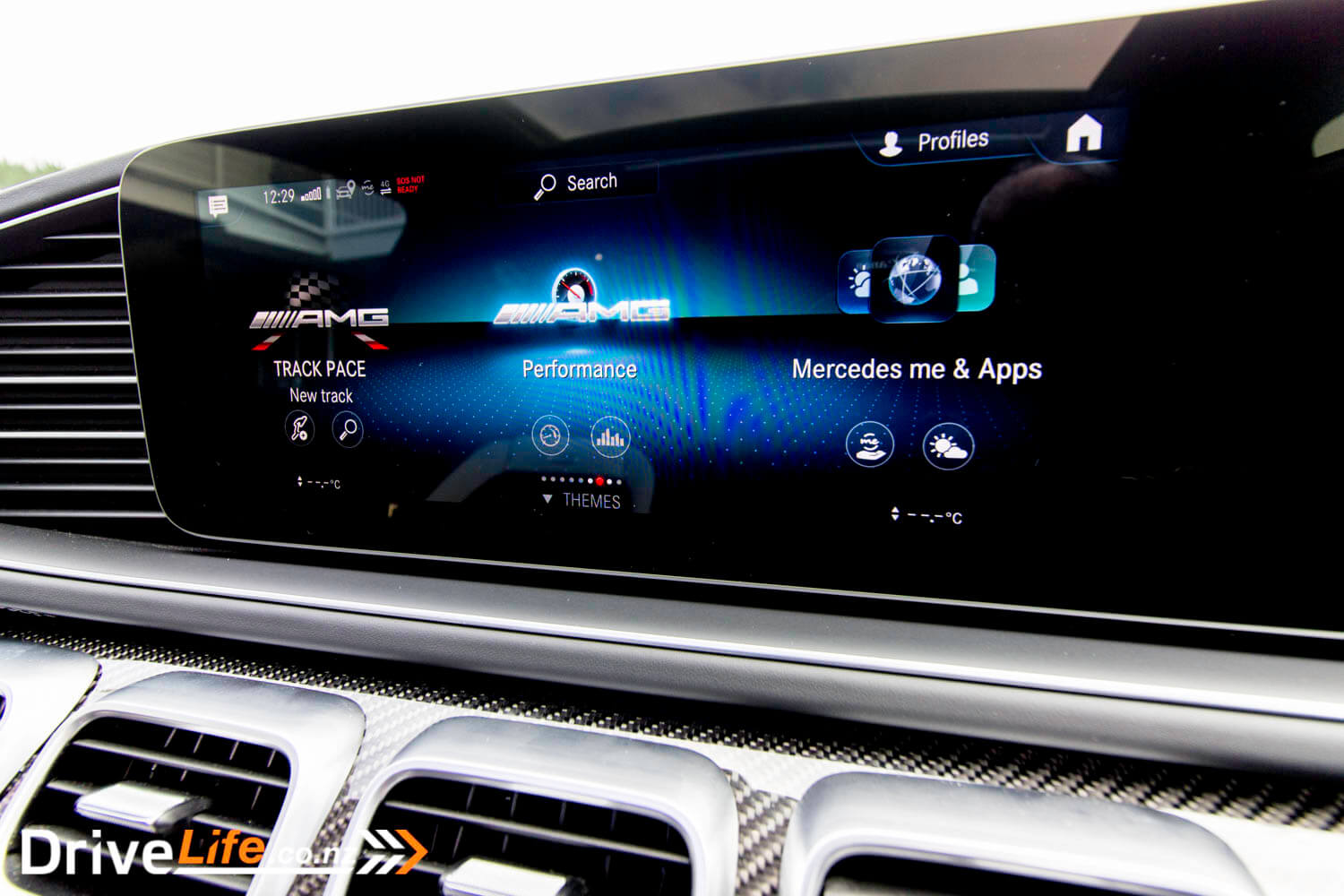
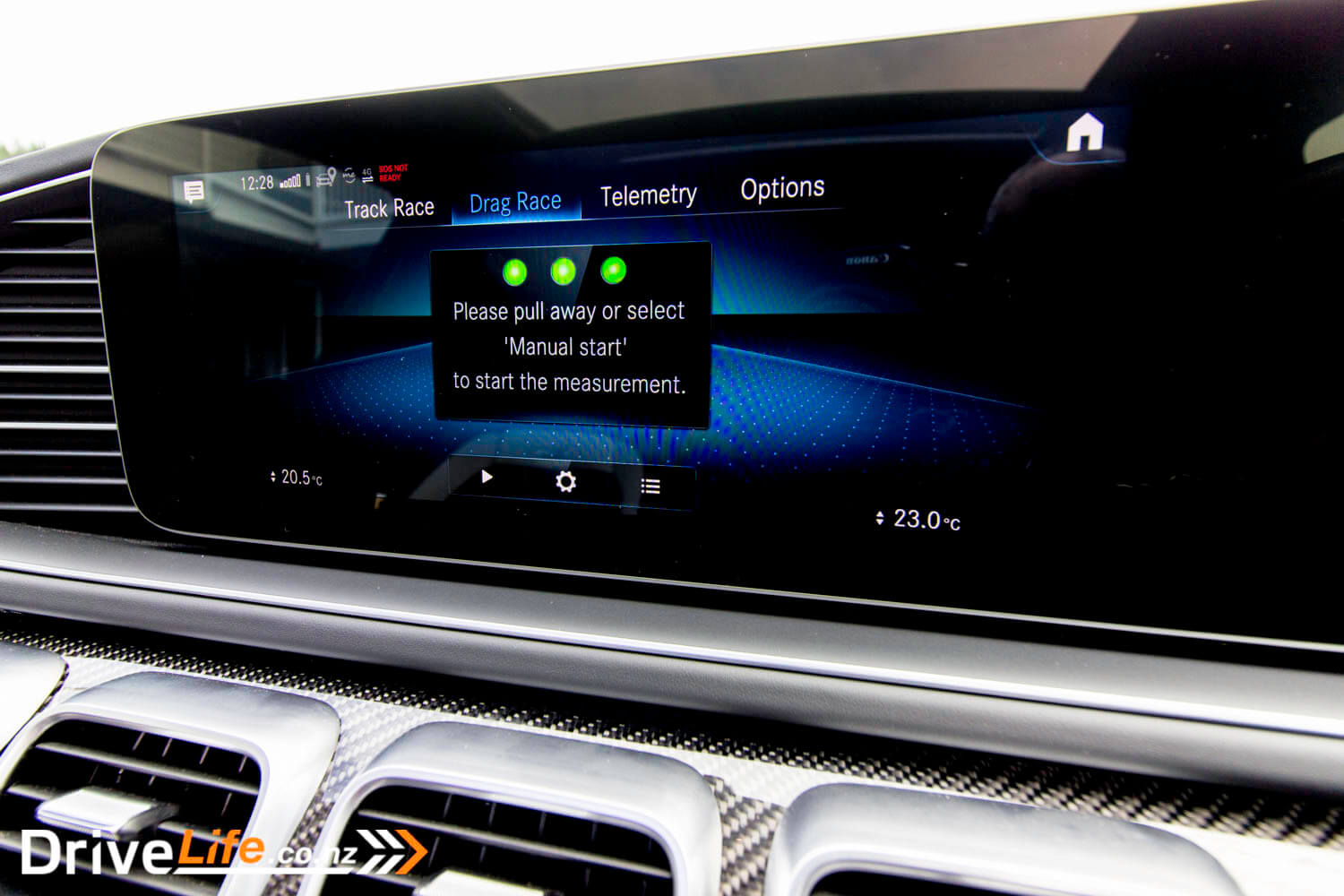
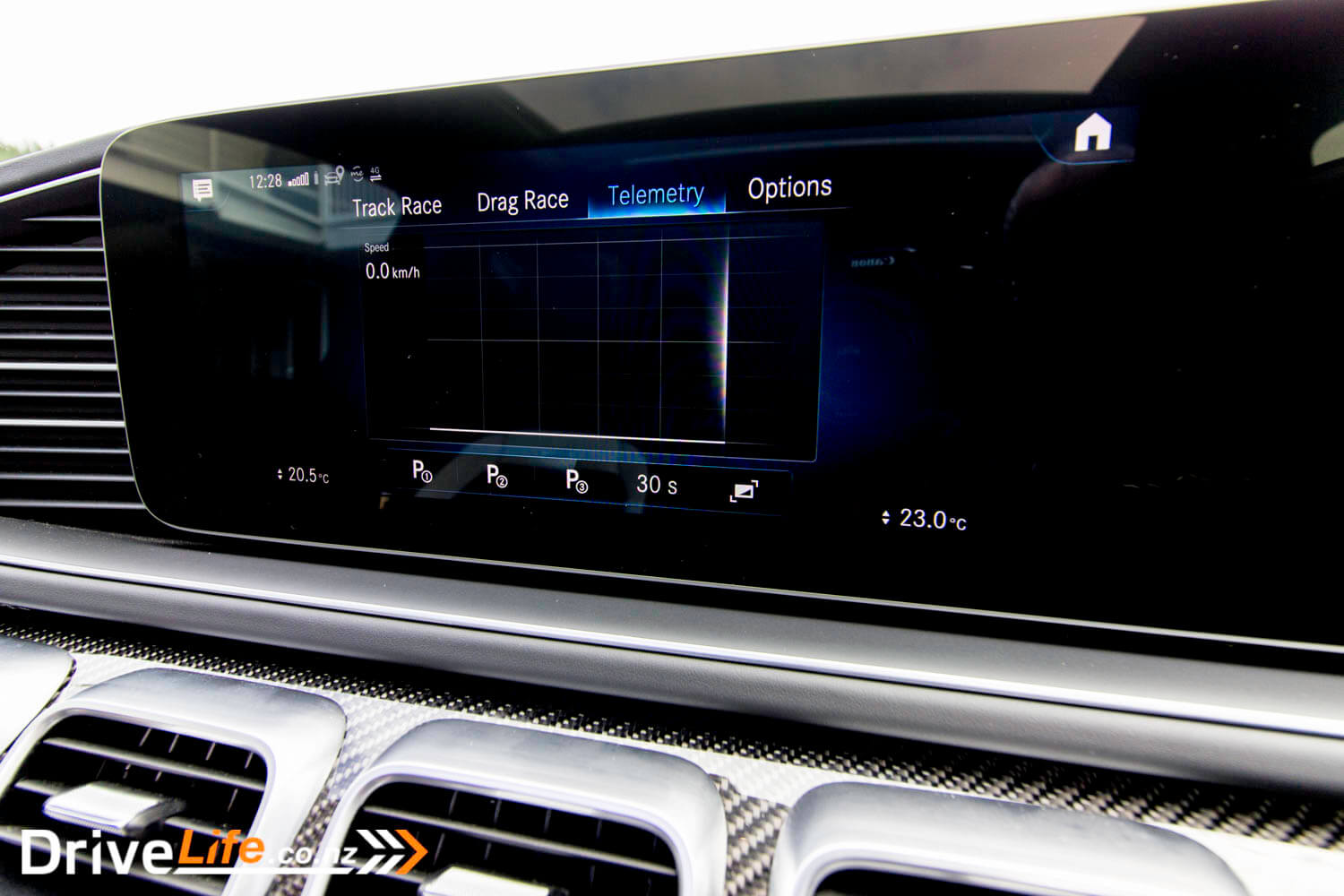
Under Racetrack, there’s another screen, Drag Race. Naturally, I didn’t get to test this out, but I’m sure it would have been fun to. You get Telemetry, Speed and Time Graphs on this screen.
The centre console has standard MB functions, with extra changes for this AMG model. On the very left is the control to switch the gearbox from auto to manual mode, meaning you are going to have to use the paddles to change gears. Next one along switches traction control off (not advisable with 600hp), then there’s the ride height selector, next is the switch to adjust suspension settings, and lastly the button to open or close the second exhaust pipe. Out the rear of the car are two massive exhaust tips, but naturally these are ‘fake’ and the actual exhaust pipes end just before the tips. Looking at the exhaust pipes, one is larger than the other, which looks pretty cool and takes the place of exhaust butterflies. Instead of butterflies, hitting the ‘loud exhaust’ button will open up the second, smaller pipe.
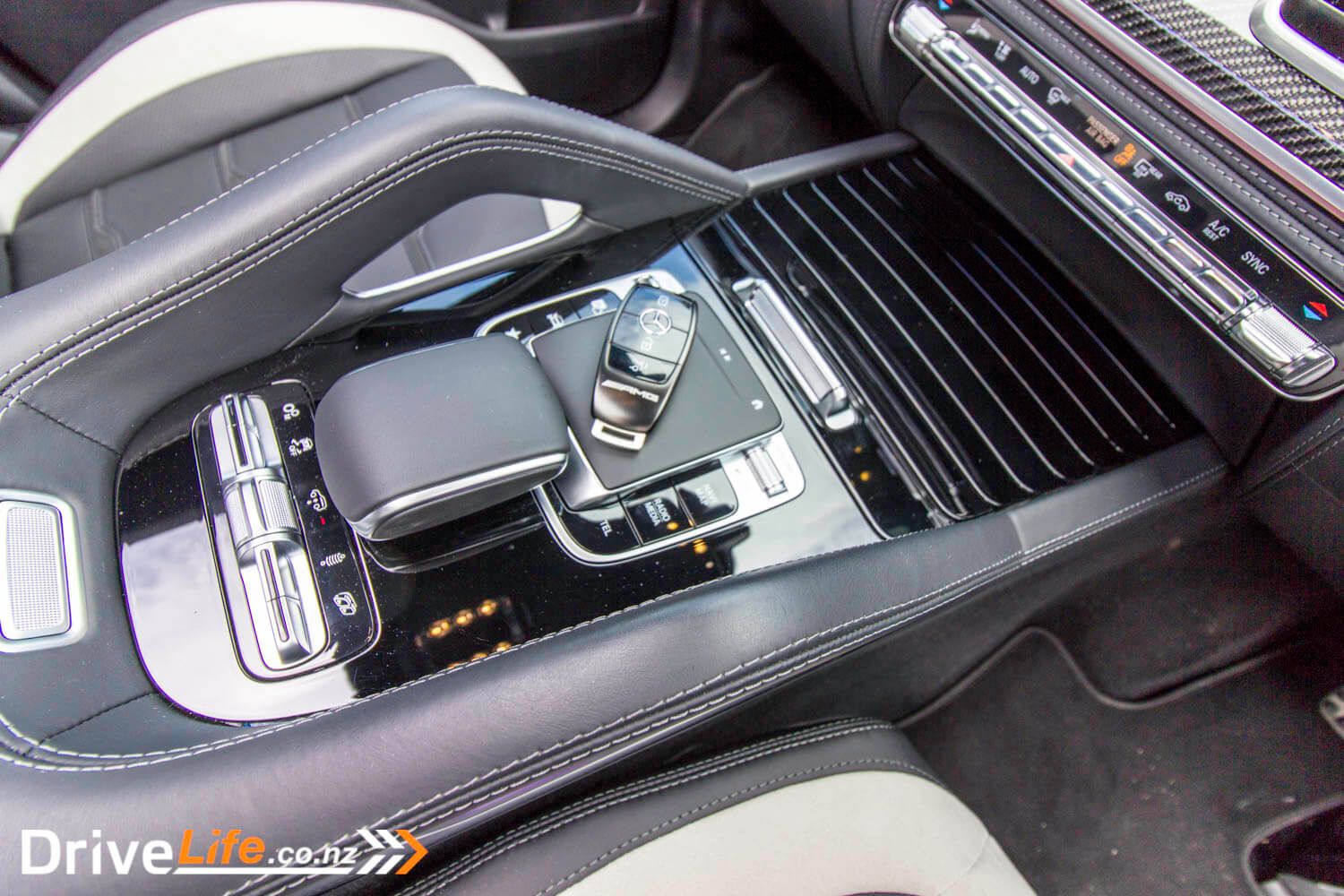
Note that as well as the centre console button to change drive modes, you also use the AMG-only steering wheel controls. As mentioned, while the controls look and feel cheap, it’s quite neat that each one has its own tiny display to show you what mode you have selected. The very left-hand control on the left side of the wheel alters the AMG performance settings, and (for example) the little display on top of the button will show Advanced, if that’s what you’ve selected. Other options are Basic, Pro, and Master. Parameters such as response of the engine and suspension, or the control thresholds of the redeveloped ESP system, are all intelligently adapted according to the AMG mode you pick.
The next button on the left side alters the suspension settings, and then the right side has just the one big dial, to change your drive modes. It shows a ‘C’ for Comfort model, S+ for Sport+, etc. You can also simply push this button in, and it will change to an ‘I+’ for Individual mode, changing all the settings to whatever it is you have chosen. If you want to switch back to the mode before, you simply push the button in again. The available modes in this model are Slippery, Trail, Comfort, Sport, Sport+, and Race.

Surprisingly, the ride comfort in nearly all the levels is excellent; even in Race mode, it’s acceptable to use on smoother roads. I found Sport+ usable nearly all the time, as far as ride quality goes.
But if you do switch to one of the more aggressive modes, the car’s character changes instantly as well. In Comfort mode, you can tootle around quite serenely, and still punch the gas pedal if you need to. It’s all very civilised. But switch to Sport, Sport+, or Race, and the car takes on a whole new demeanour; Sport mode upwards is not for the faint-hearted. But if you are using those other modes in the right conditions, you’ll be rewarded with dinner and a show. The noises are phenomenal; this is an absolute highlight of this car, as those twin turbos and that 4.0-litre V8 can really sing some tunes. Of course, acceleration is pretty bloody stunning. Not just off the mark – hell, 3.8 seconds to 100km/h in a 2.5-ton SUV is pretty impressive. But it’s the mid-range where the car really shines. Get some revs up, floor it, and the whole car shoots forward at an incredible pace of acceleration. It’s more impressive than the off the line performance. Speaking of off the line, watching that bonnet rise up as soon as you punch that gas pedal is quite a sight; 850Nm of torque is pretty hard to rein in on hard acceleration.
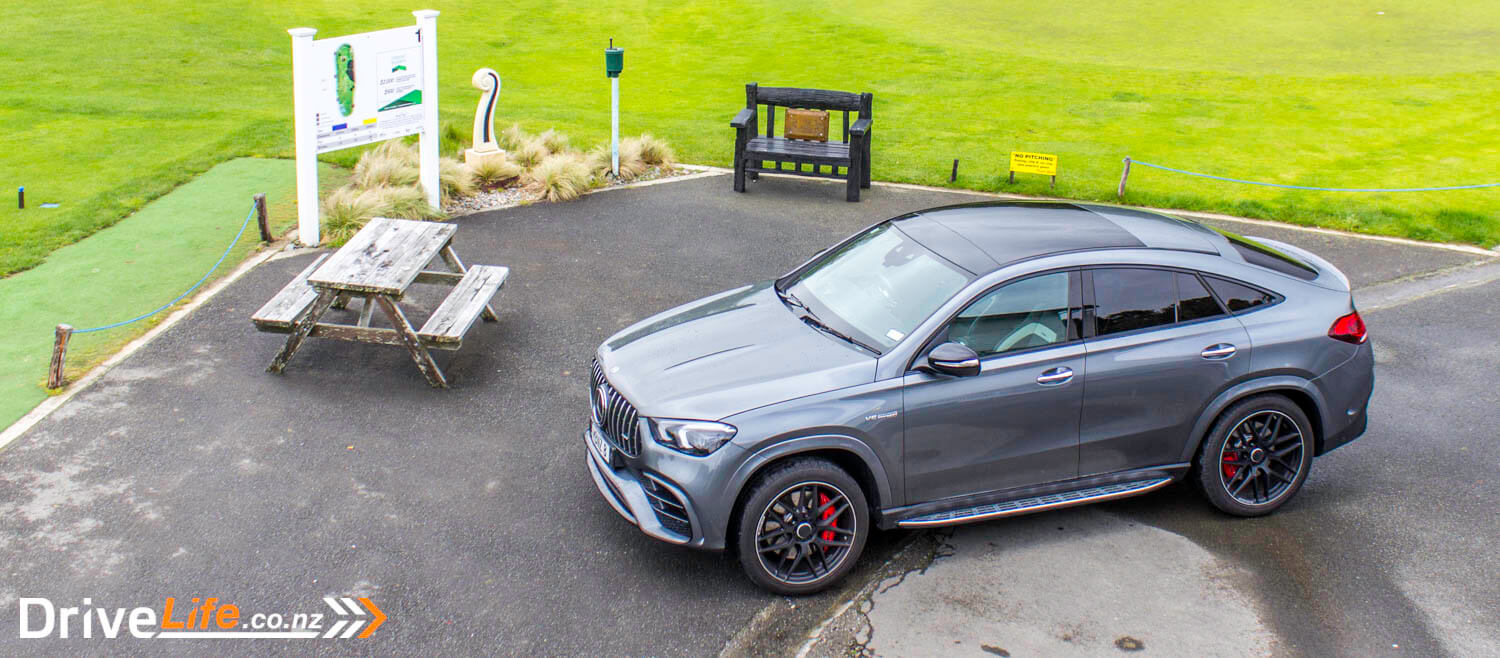
But with 850Nm and 450kW comes great responsibility. If you are on any sort of a bend and hit the gas pedal, the rear will twitch some, until electronics kick in. It doesn’t last long – maybe half a second – but it can catch you unaware. Depending on the road conditions and the bends, you can get the rear wheels to spin too – again though, it’s a pretty brief time that it happens, but it does happen. The standard tyres on this car are Yokohama Advan Sport, and it was a shame we didn’t get some sort of dry weather during our testing, to truly test those tyres out.
Turbo lag? What turbo lag? Well, I can almost say that. In Comfort mode, there is a little hesitation off the line if you floor it. But in Sport mode or above, that disappears. Part of this is no doubt down to the 48-volt EQ Boost system, helping the car to get off the mark while the turbos spool up.
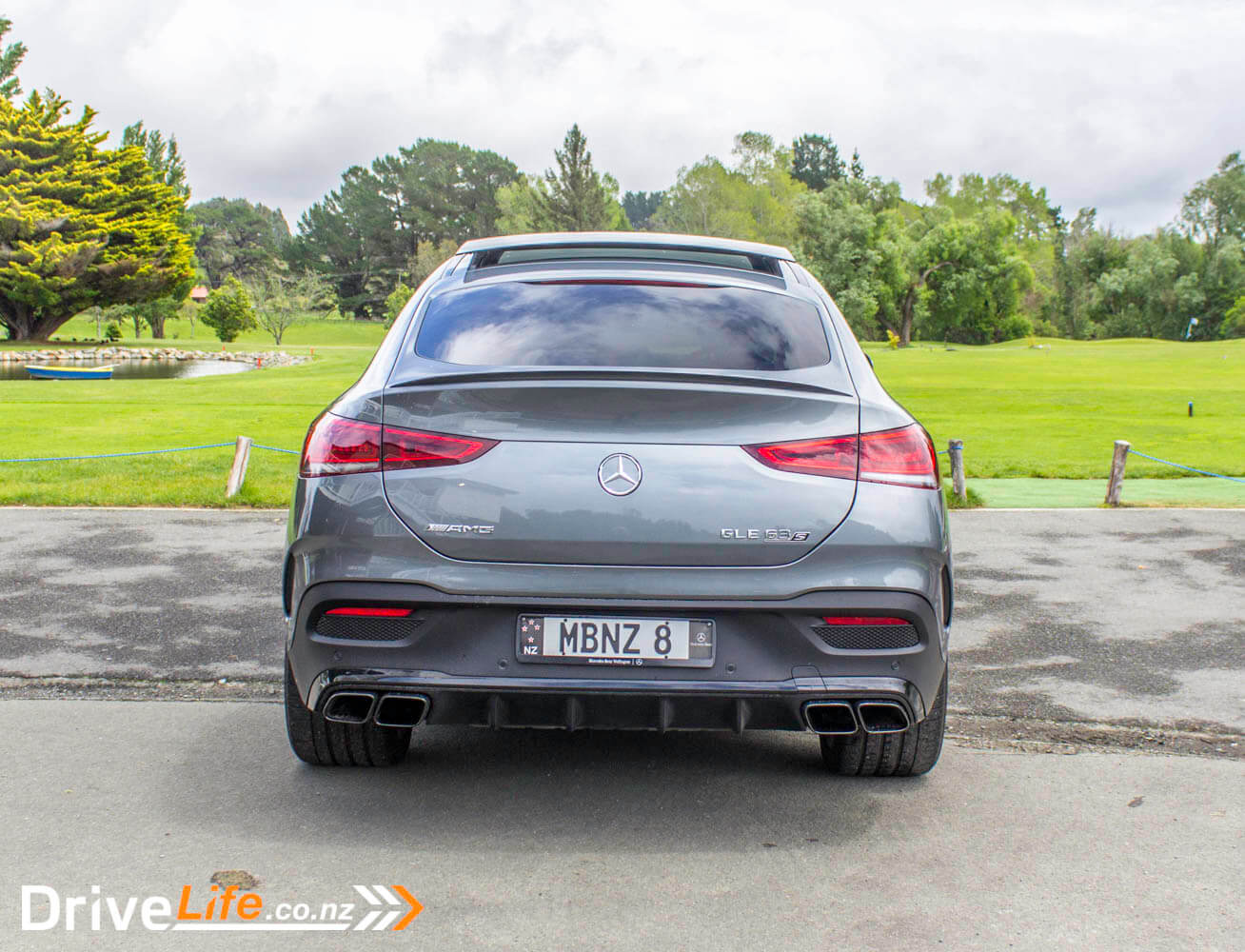
As we’ve found with other AMG models, gear changes are snappy-quick when you are driving in one of the Sport modes. You might expect a little ‘brap-brap’ on the upchange, and you won’t be disappointed. Noises are what this car is all about. With lightning-quick gear changes and incredible performance, some serious braking is required. The AMG GLE has this sorted in spades with massive discs front and rear; braking power is never an issue. It’s nice too that there’s some fantastic brake feel to the pedal, and you can modulate them beautifully. This does mean if you are on some twisty roads, you can use the performance of the car (to a point of course – this is New Zealand, after all) and then modulate the brakes, making for a perfectly smooth drive. Your passengers might never know how fast you are truly going.

You might be thinking that fuel economy is not going to be one of the strengths of this car, and you’d be right. Over 500km of driving, I averaged 14.2L/100km. Is that bad? The stated figure is 11.5L/100km, and in the scheme of things and the performance that begs to be used, 14.2 is excellent. It’s a bit frightening when you move off from the lights on a gentle throttle and the fuel ‘economy’ gauge shoots up to 100L/100Km, so best not to have that display showing on the heads-up display (HUD).
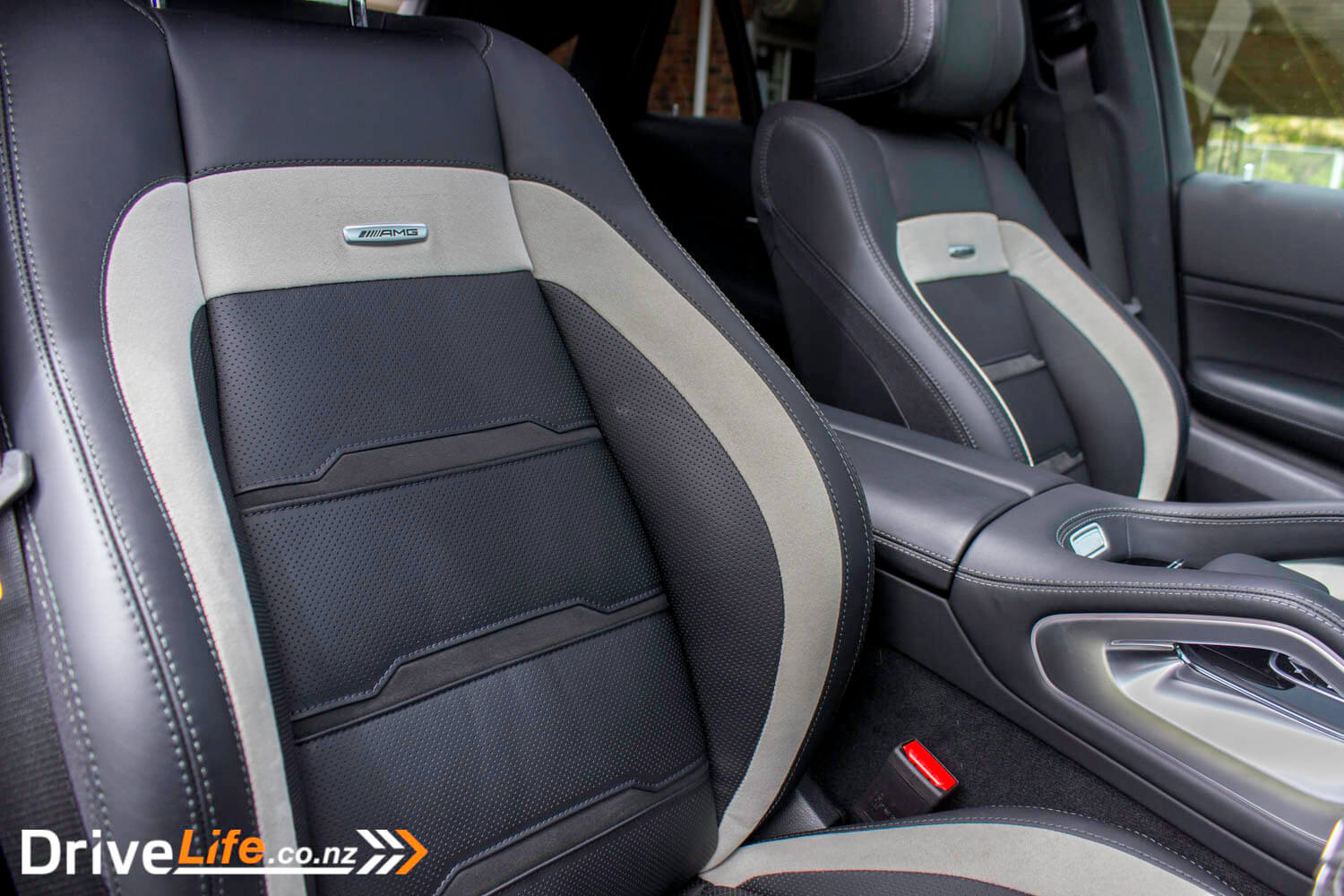
Speaking of the HUD, it’s pretty much the same as the one in the diesel, but there is a performance aspect to it. As discussed in our review, there’s three panels to the HUD, and you can select from a range of displays for each panel. Generally, I’d have the current speed limit up, the actual speed of the car, and fuel economy or SatNav, if I was using it. If you want to, however, you can switch it up so a rev counter shows up over two or even all three of the panels; a long bar-type rev counter, with the current gear shown underneath it. With the speed in which this engine revs out, it’s pretty essential if you are running the transmission in manual mode.
One slight glitch with the HUD, hopefully fixed on a later version; if you are using SatNav, you have to manually go into the menus of the HUD to select it for one of the panels – if you didn’t already have it on SatNav. Ideally, when you start using SatNav to get somewhere, I think the HUD should automatically switch to SatNav. Small gripe, though.
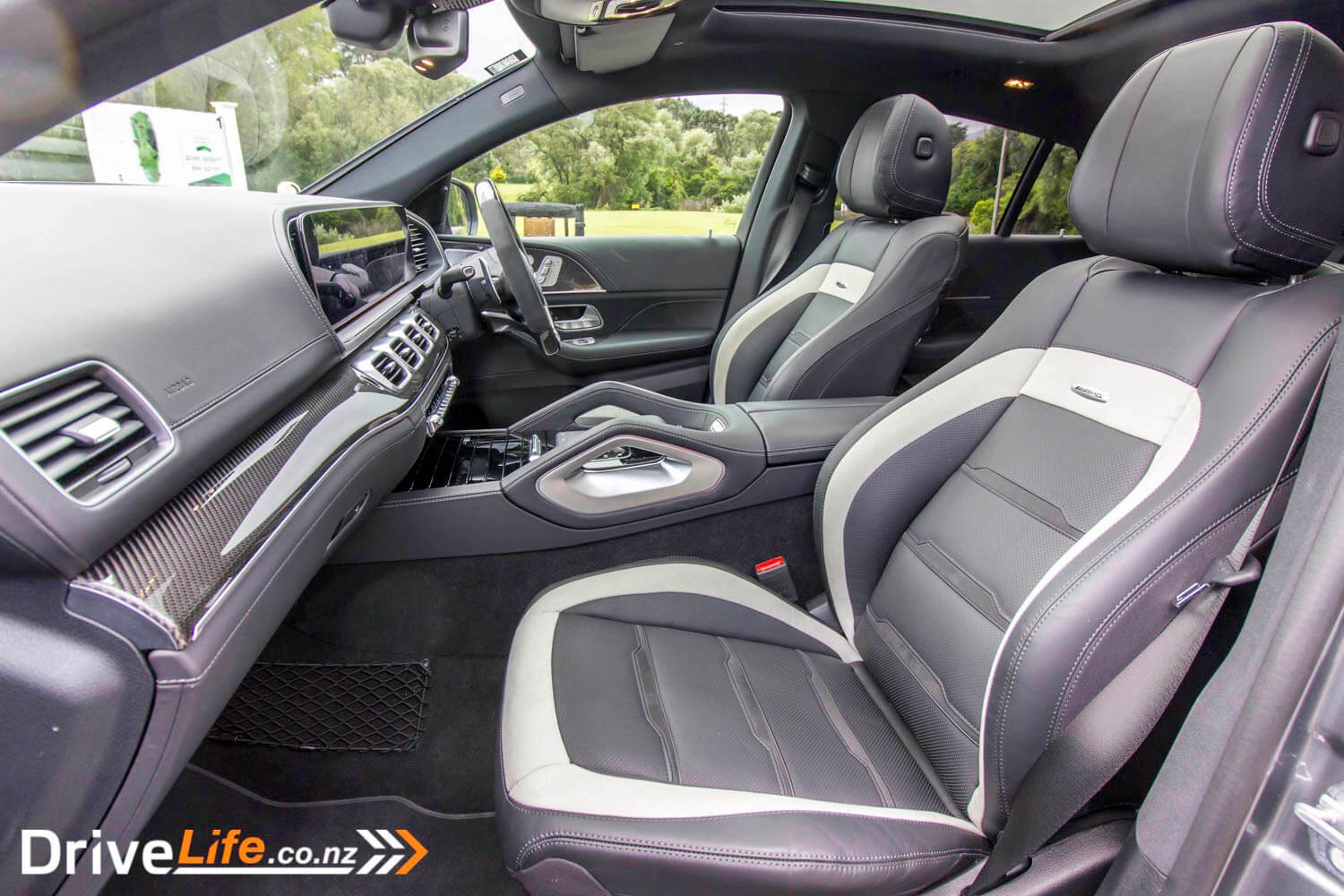
The AMG GLE 63 S does have a 4-cylinder mode, so the engine will switch to four cylinders when it can. This actually happens quite often, and is shown on the dash with an icon, and there’s also a subtle change in the exhaust note.
Another strange omission on the AMG GLE; there’s no grab handles for any passengers. Not sure why, but with no running boards, anyone climbing up into the car mentioned this.
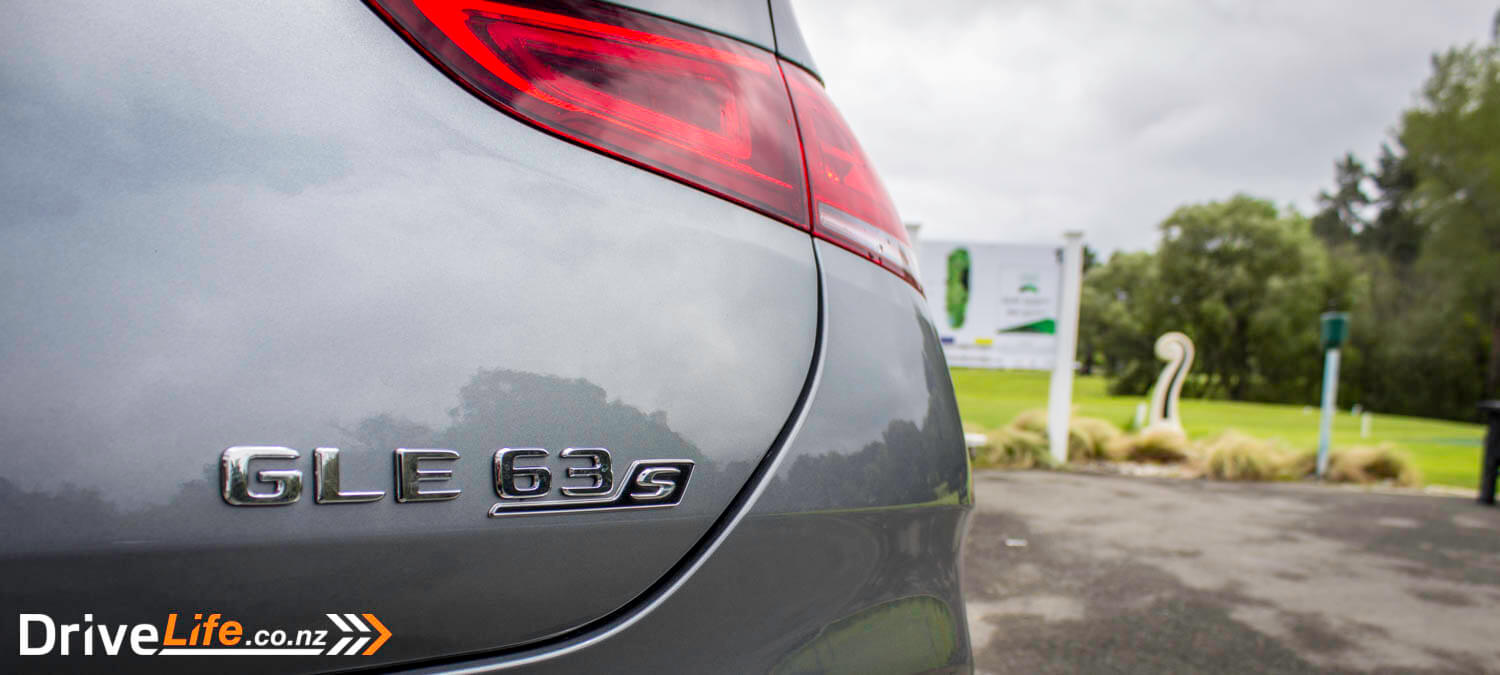
At near-on a quarter of a million dollars, thankfully adaptive cruise control is a standard feature, and not only brings you to a stop, but will start off again automatically. I love this feature in traffic, as it removes all the stress of start/stop traffic jams. And believe me, in this car you will need to use adaptive cruise quite a bit. With the height of the car, it’s deceptive how fast you are driving, and the legal speed limit comes up very quickly. It’s either use cruise control, or of course there’s the speed limiter option as well. If using adaptive cruise, you can also double tap the Resume button, which will set the speed of the car to the current speed limit.
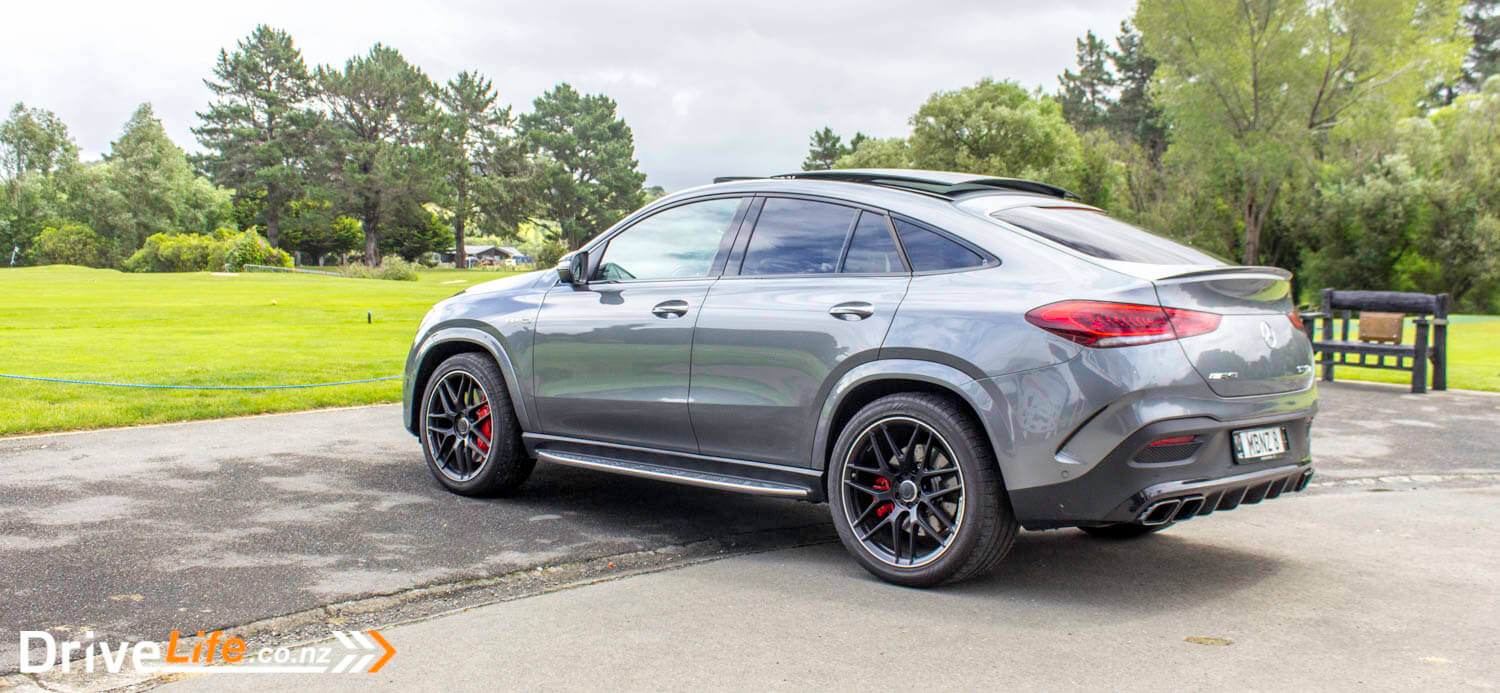
Many thanks to Judgeford Golf Course for the use of their grounds for photos.
What’s The Competition For The 2020 Mercedes-AMG GLE 63 S Coupe?
| Brand/ Model | Engine | Power/ Torque kW/Nm | Cargo capacity litres | 0-100Km/h seconds | Fuel consumption L/100km | Price |
| Panamera GTS Sport Turismo AWD | Twin-turbo, 4.0-litre V8 petrol | 353/620 | 495 | 3.9 | 13.1 | $280,600 |
| Audi RSQ8 AWD | Twin-turbo, 4.0-litre V8 petrol | 441/800 | 605 | 3.8 | 12.1 | $243,900 |
| Mercedes-AMG GLE 63 S Coupe AWD | Twin-turbo, 4.0-litre V8 petrol | 450/850 | 655 | 3.8 | 12.6 | $236,000 |
| BMW X6 M Competition Coupe AWD | Twin-turbo, 4.4-litre V8 petrol | 460/750 | 580 | 3.8 | 12.5 | $225,600 |
| Porsche Taycan 4S AWD | Electric | 320/640 | 407+84 | 4.0 | n/a | $203,900 |
What’s The Pros and Cons For The 2020 Mercedes-AMG GLE 63 S Coupe?
| Pros | Cons |
| Performance Sounds Handling Brakes Seat comfort Interior Engine noises EQ Boost system Overall quality | No grab handles No rear wiper Tiny rear window I would lose my license Some steering wheel controls feel cheap |
2020 Mercedes-AMG GLE 63 S Coupe – Specifications
| Vehicle Type | Large, all-wheel drive, high-performance luxury SUV |
| Starting Price | $236,000 |
| Price as Tested | $241,100 |
| Engine | Twin-turbocharged, 4.0-litre, V8 petrol with 48-volt EQ Boost mild hybrid system |
| Power, Torque kW/Nm | 450kW@5750-6500rpm 850Nm@2500-4500rpm |
| Transmission | 9-speed automatic |
| 0-100km/h, seconds | 3.8 |
| Spare Wheel | Space Saver |
| Kerb Weight, Kg | 2,445 |
| Length x Width x Height, mm | 4961x2018x1720 |
| Cargo Capacity, litres | 655/NA |
| Fuel capacity, litres | 85 |
| Fuel Efficiency | Advertised Spec – combined – 11.5L/100km Real World Test – combined – 14.2L/100km Low Usage: 0-6 / Medium Usage 6-12 / High Usage 12+ |
| Towing Capacity Kg, unbraked/braked | 750/3,500 |
| Turning circle, metres | 12.3 Small: 6-10m / Medium 10-12m / Large 12m+ |
| Warranty | 3 years, unlimited KM |
| ANCAP Safety Ratings | 5 Star |


